Embarking on a backpacking adventure across Southeast Asia is often considered the pinnacle of travel experiences. It’s a journey that promises a rich tapestry of cultures, breathtaking landscapes, fascinating history, and mouthwatering cuisine. For many, the dream route involves exploring the vibrant trio of Vietnam, Cambodia, and Thailand. This guide delves into the heart of Backpacking Thailand Vietnam Cambodia, sharing a detailed itinerary, practical tips, and the unforgettable experiences that await you in this captivating corner of the world.
Mainland Southeast Asia, sometimes referred to as Indochina, is a region brimming with diversity. It encompasses countries like Myanmar, Thailand, Laos, Cambodia, and Vietnam. While each nation has its unique identity, exploring them together offers a compelling narrative of shared history, intertwined cultures, and stunning natural beauty. The journey from Vietnam through Cambodia to Thailand is a classic route, popular for its accessibility, relatively low cost, and incredible array of sights and sounds.
Planning such a trip might seem daunting, but the rewards are immense. You’ll traverse bustling metropolises, serene ancient ruins, lush river deltas, and vibrant street markets. The experience is immersive, challenging you to adapt to new environments while constantly surprising you with unexpected wonders. This detailed guide outlines an 11-day itinerary, offering a blueprint that balances key highlights with authentic local interactions, perfect for those interested in Backpacking Thailand Vietnam Cambodia.
While 11 days allows for a comprehensive taste of each country, this itinerary can be adjusted. If your time is limited, focusing on essential highlights can condense the trip to around 7 days, primarily covering Ho Chi Minh City, Siem Reap, and Bangkok. However, allowing more time lets you delve deeper, like exploring the serene beauty of Chiang Mai.
Your Itinerary for Backpacking Thailand Vietnam Cambodia
Starting your adventure in Ho Chi Minh City (Saigon), Vietnam, offers a dynamic entry point into the region’s energy. This bustling city is a blend of historical depth and modern vitality, setting the stage for the diverse experiences ahead. From here, the path leads to the ancient wonders of Cambodia before culminating in the popular tourist hubs and northern charm of Thailand.
Day 1: Arrival in Ho Chi Minh City, Vietnam
The journey begins! Landing in Ho Chi Minh City marks the official start of your Backpacking Thailand Vietnam Cambodia expedition. After arriving, settling into your accommodation is key. Many backpackers opt for hostels or guesthouses in the Pham Ngu Lao or Bui Vien area, known for its lively atmosphere, affordable food options, and ease of access to transportation.
The first evening is perfect for simply soaking in the city’s ambiance. Head to Bui Vien Walking Street, a hub of nightlife, street food vendors, and casual restaurants. It’s an assault on the senses in the best possible way – the aroma of Vietnamese dishes fills the air, music plays from various establishments, and travelers from around the world mingle. Finding a spot for dinner and enjoying a local beer is a fantastic way to ease into the rhythm of Vietnam.
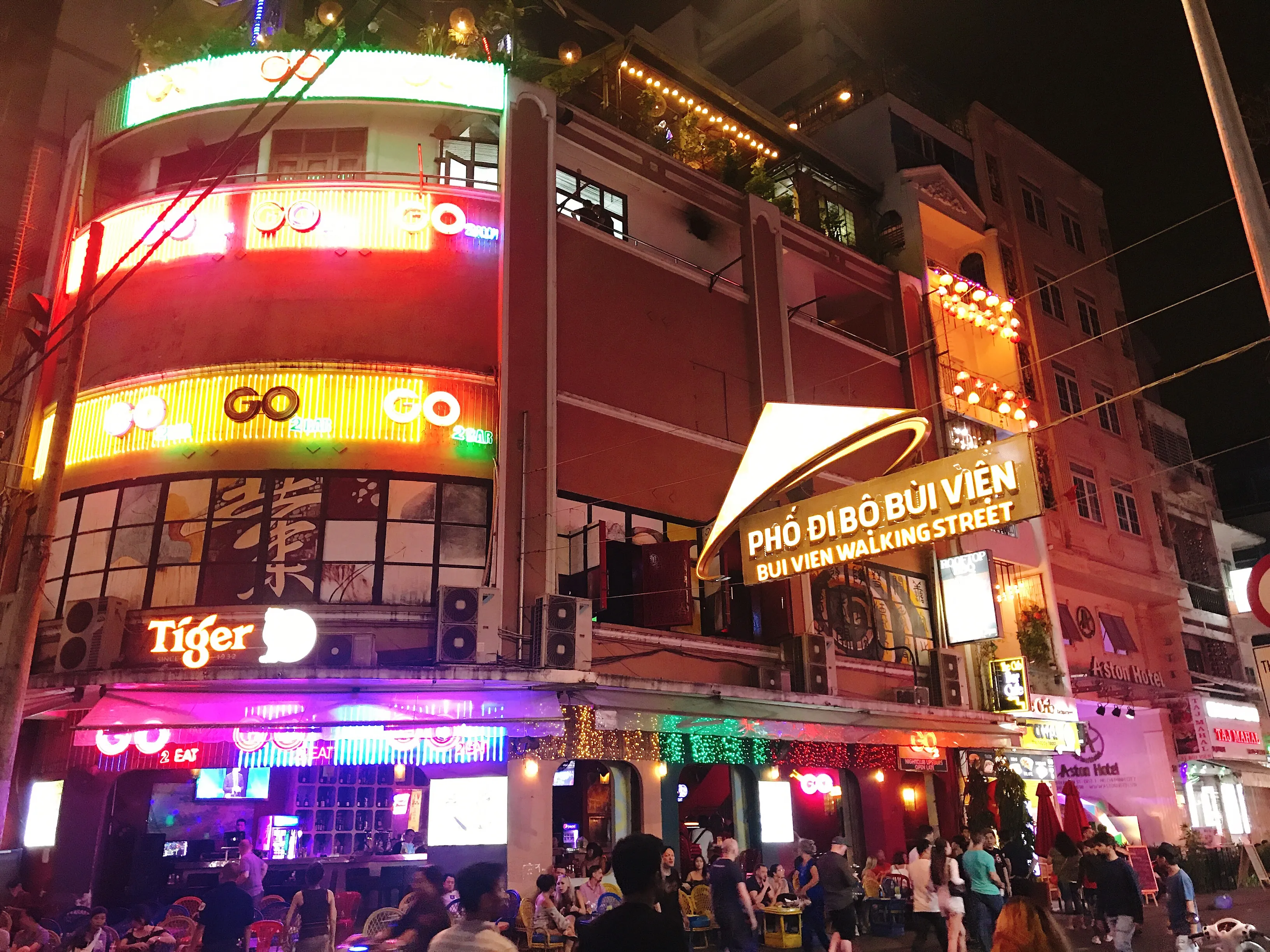 Pho Bui Vien in Saigon- arrival in Ho Chi Minh
Pho Bui Vien in Saigon- arrival in Ho Chi Minh
What to Eat in Fort Worth – A Culinary Deep Dive
Discover the Top Restaurants in Denver – A Culinary Journey
Discover Where to Visit in Las Vegas
Exploring the food stalls is a must. Try a bowl of traditional Pho or a Banh Mi from a street vendor. The energy of Bui Vien provides an immediate immersion into the vibrant street life that characterises much of Southeast Asia, offering a glimpse into the cultural fabric that makes Backpacking Thailand Vietnam Cambodia so rewarding.
Day 2: Ho Chi Minh City Exploration
Day two is dedicated to exploring the historical and cultural landmarks of Ho Chi Minh City. A DIY city tour is easily achievable on foot or using ride-hailing apps. The city center is relatively compact and walkable, especially around the Dong Khoi area. Key sites reflect the city’s colonial past and its significant role in the Vietnam War.
Begin with architectural marvels like the Saigon Notre Dame Basilica, a stunning cathedral built during the French colonial era. Just opposite is the historic Saigon Central Post Office, designed by Gustave Eiffel. Its grand interior is still a functioning post office and a beautiful example of French colonial architecture.
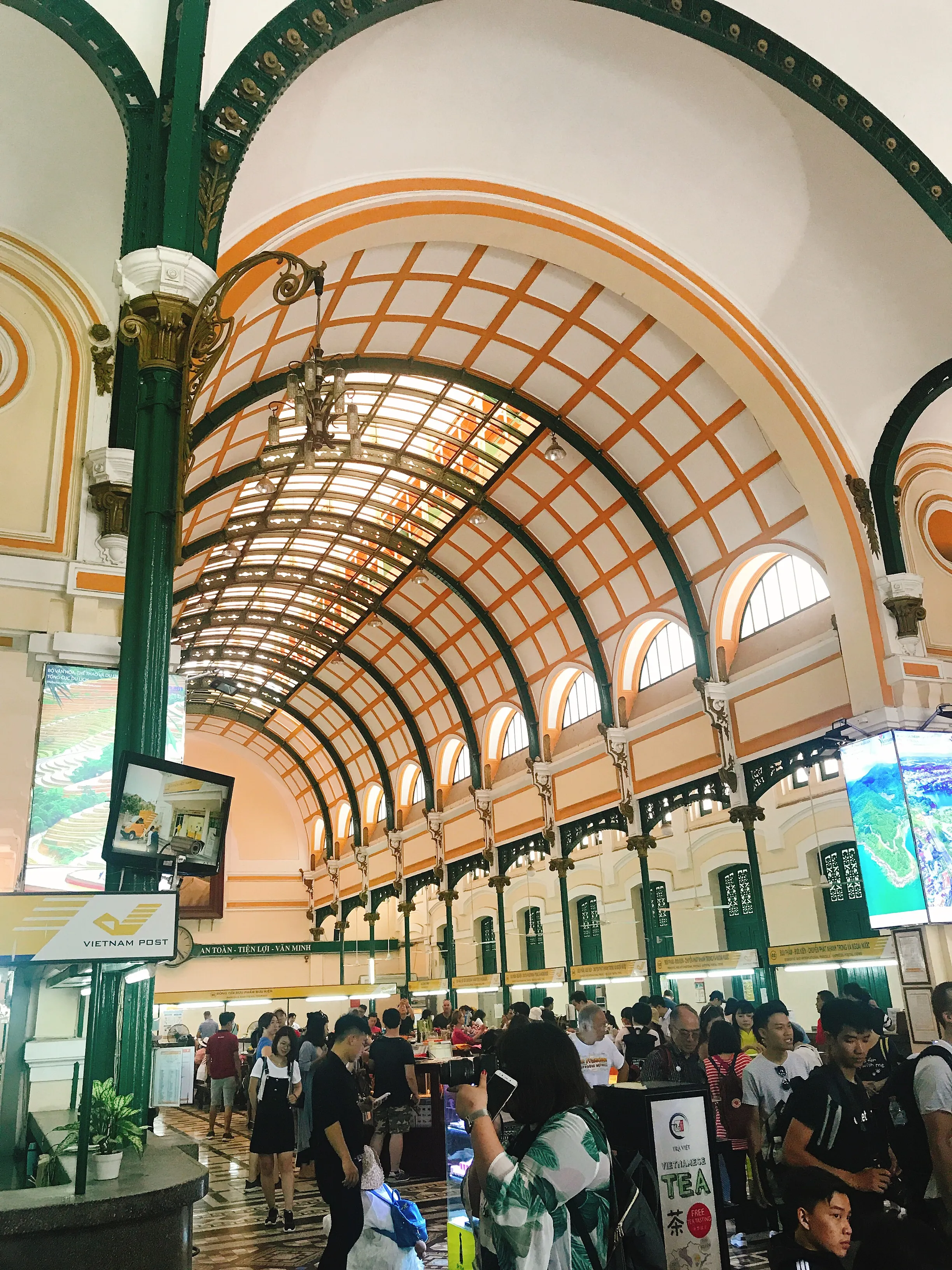 Historic Saigon Central Post Office architecture in Ho Chi Minh City, Vietnam
Historic Saigon Central Post Office architecture in Ho Chi Minh City, Vietnam
Nearby historical sites include the Reunification Palace (formerly the Presidential Palace), which played a pivotal role in the end of the Vietnam War, and the War Remnants Museum, offering a powerful and moving perspective on the conflict. While emotionally challenging, visiting the museum provides crucial historical context.
Lunch can be enjoyed at a local eatery, perhaps trying Banh Xeo (sizzling savory crepe) or Bun Cha (grilled pork with vermicelli). The afternoon can be spent exploring Ben Thanh Market for souvenirs, local goods, and more food. Dinner at the Ben Thanh Street Food Market offers a fantastic array of local dishes in a lively setting. This day deepens your understanding of the country’s past as part of your Backpacking Thailand Vietnam Cambodia adventure.
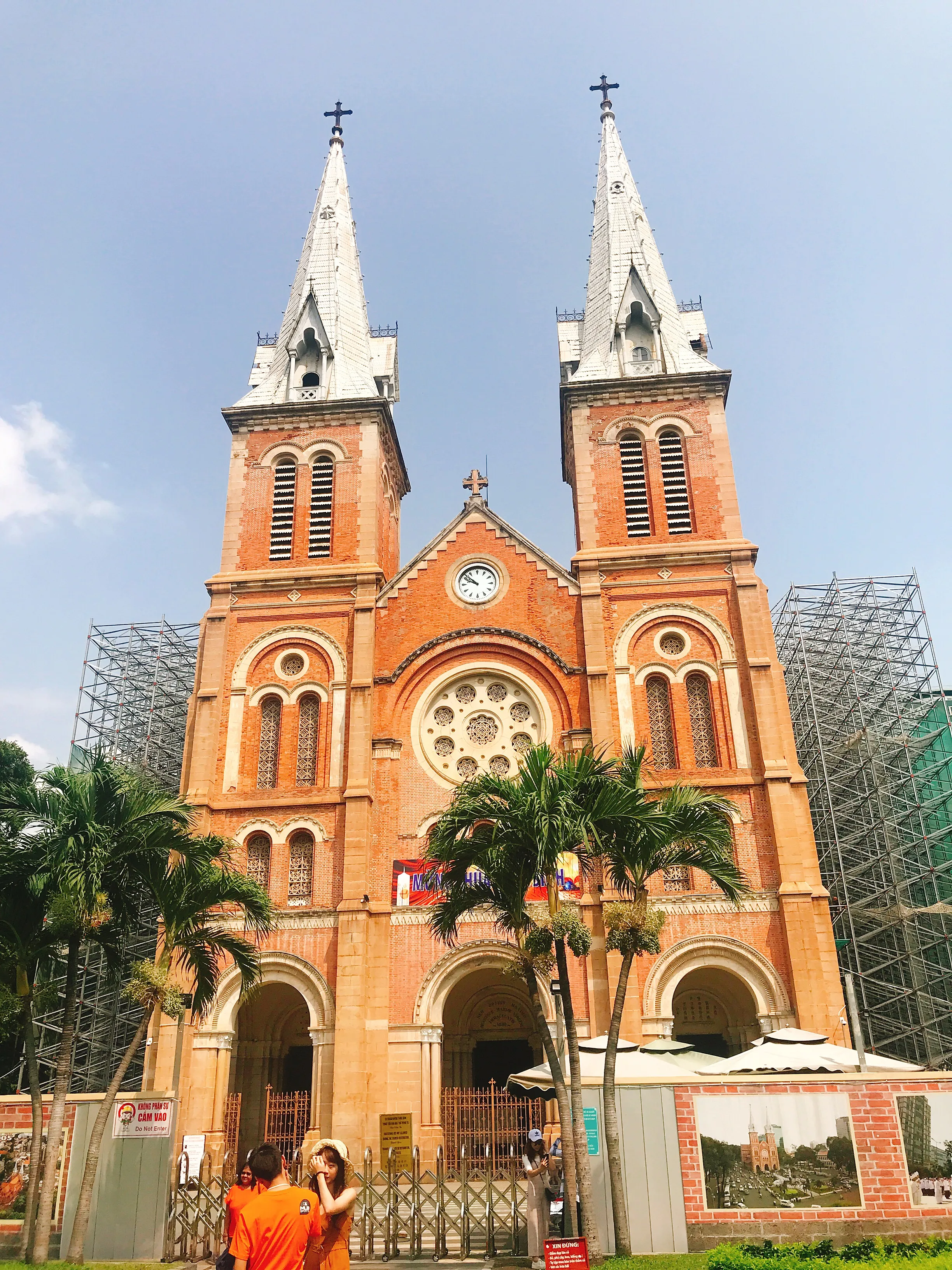 Saigon Notre Dame Basilica, a historic landmark in Ho Chi Minh City
Saigon Notre Dame Basilica, a historic landmark in Ho Chi Minh City
For more details on exploring this dynamic city, refer to a dedicated guide like #SaigonWithTheWind : Vietnam Itinerary for 4D/3N. Exploring these sites offers profound insights into the history and resilience of Vietnam.
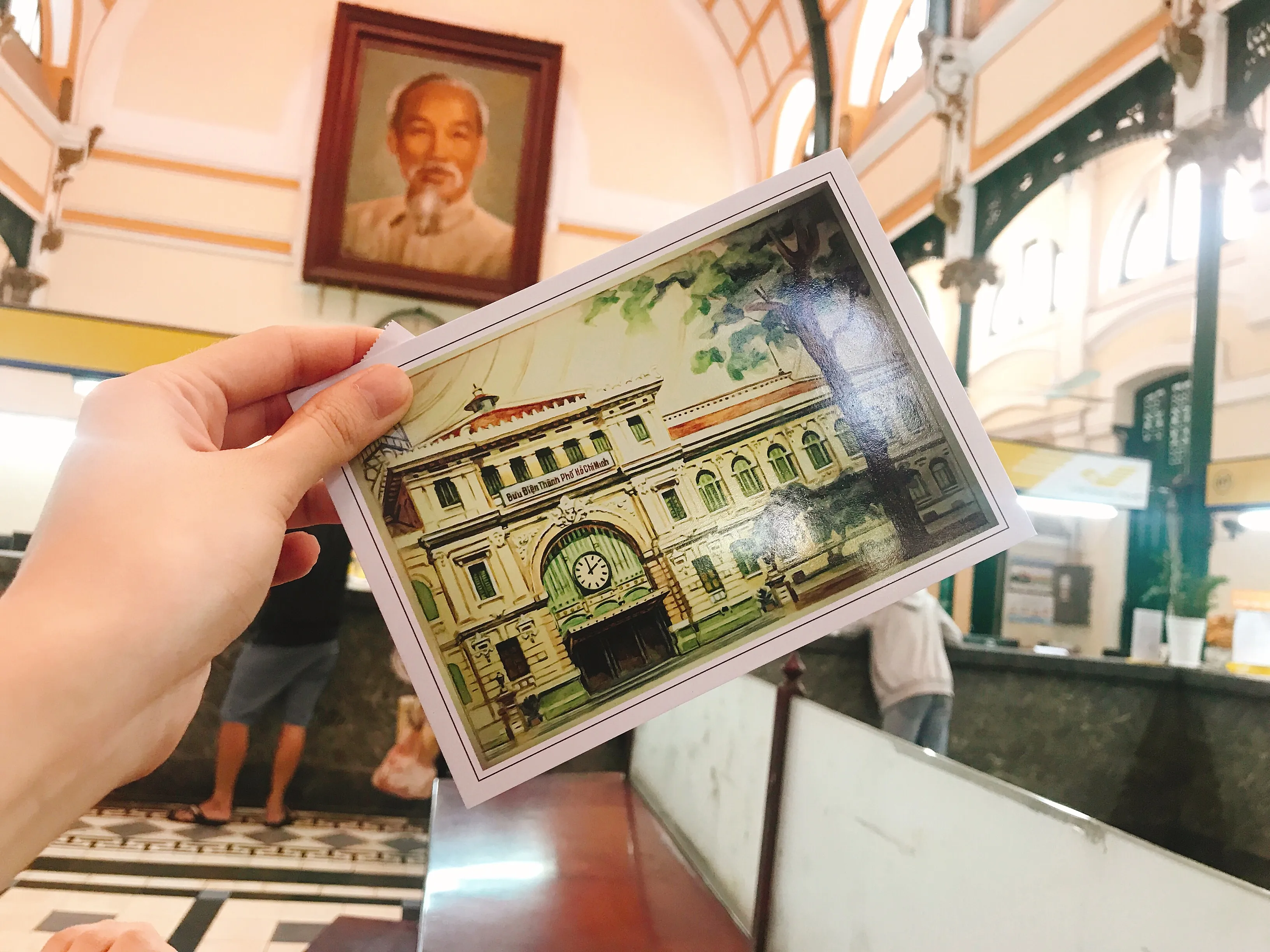 Interior view of the grand Saigon Central Post Office
Interior view of the grand Saigon Central Post Office
Day 3: Mekong Delta Excursion
A day trip to the Mekong Delta is a popular and worthwhile escape from the city’s hustle. This region, known as Vietnam’s “rice bowl,” is characterized by intricate waterways, lush landscapes, and traditional village life. Many tours are available and can be conveniently booked online or through local agents.
A typical Mekong Delta tour involves cruising along the river, visiting local workshops (like coconut candy production), sampling tropical fruits, listening to traditional folk music, and experiencing a short ride on a traditional sampan boat through narrow canals. It’s a chance to see a different side of Vietnam – slower-paced, agricultural, and deeply connected to the river.
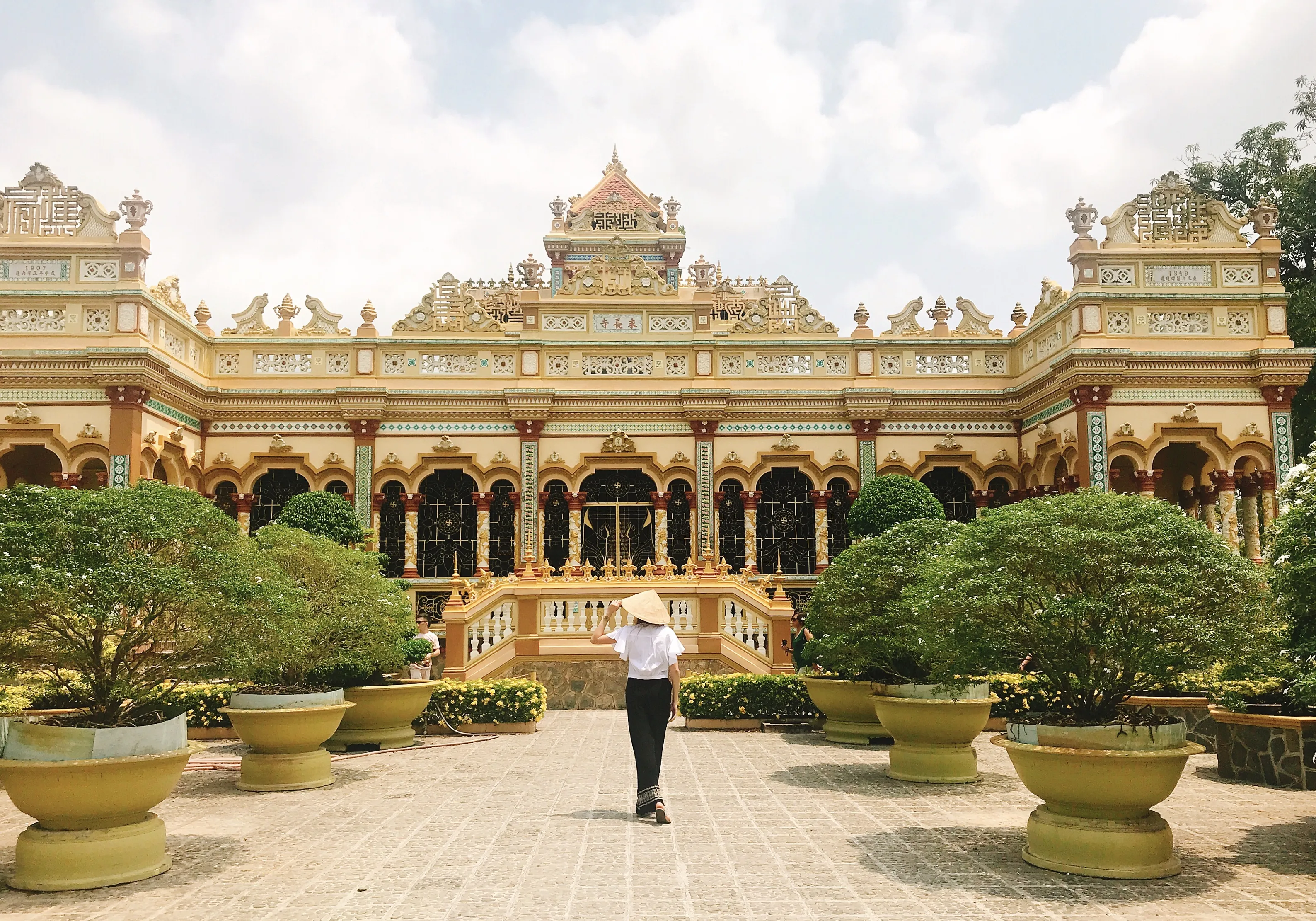 Buddhist pagoda visited during the Mekong Delta tour in Vietnam
Buddhist pagoda visited during the Mekong Delta tour in Vietnam
Lunch is usually included as part of the tour package, offering a taste of regional specialties, often featuring fresh fish from the delta. The boat rides provide picturesque views and opportunities to observe local life along the riverbanks.
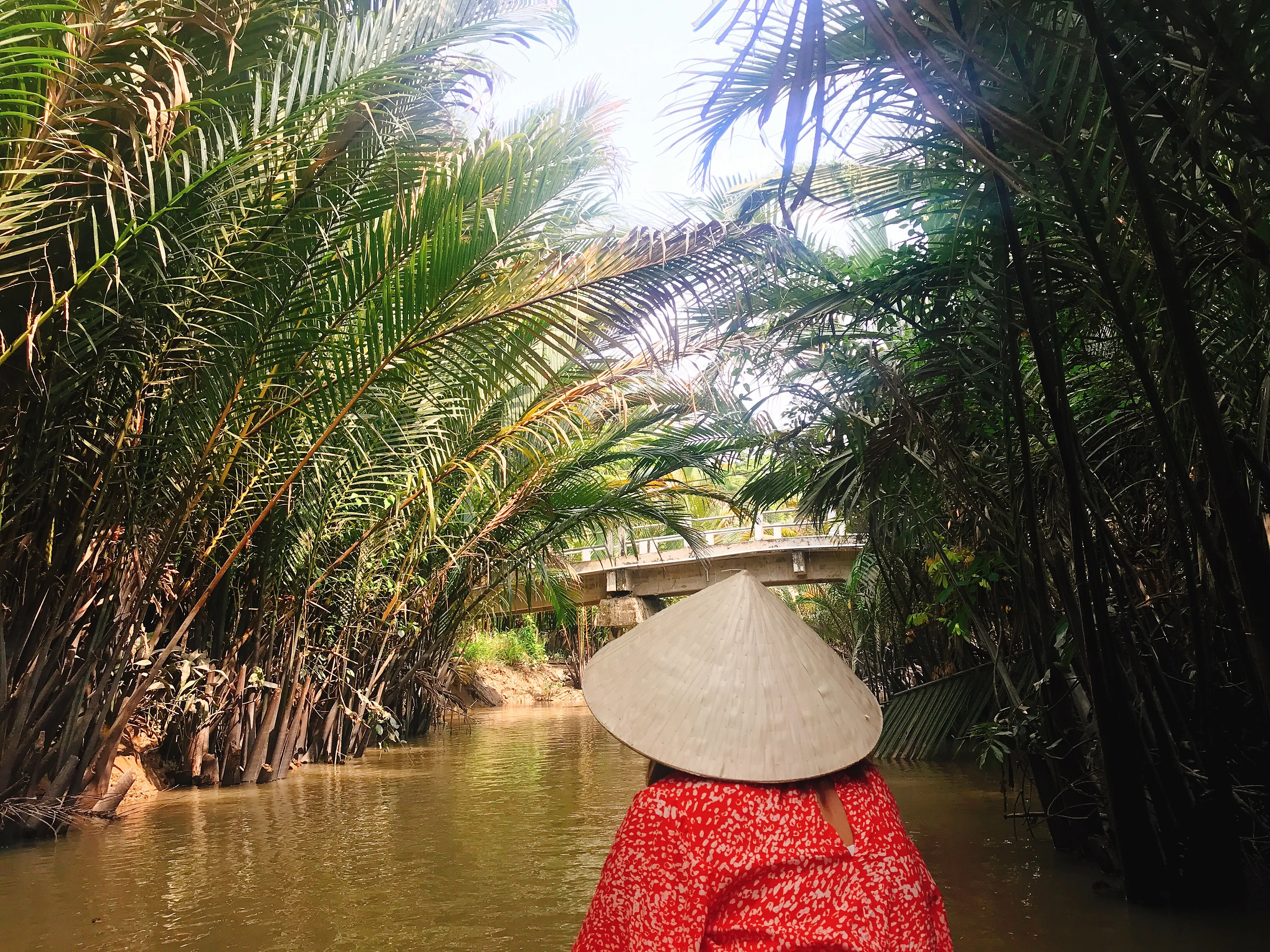 Exploring the Mekong Delta waterways by traditional sampan boat
Exploring the Mekong Delta waterways by traditional sampan boat
One memorable (and perhaps daring) experience sometimes offered is trying “snake wine,” a local beverage with preserved snakes inside the bottle. It’s certainly a talking point! The delta trip adds a natural and cultural dimension to your Backpacking Thailand Vietnam Cambodia journey, showcasing Vietnam’s rural beauty.
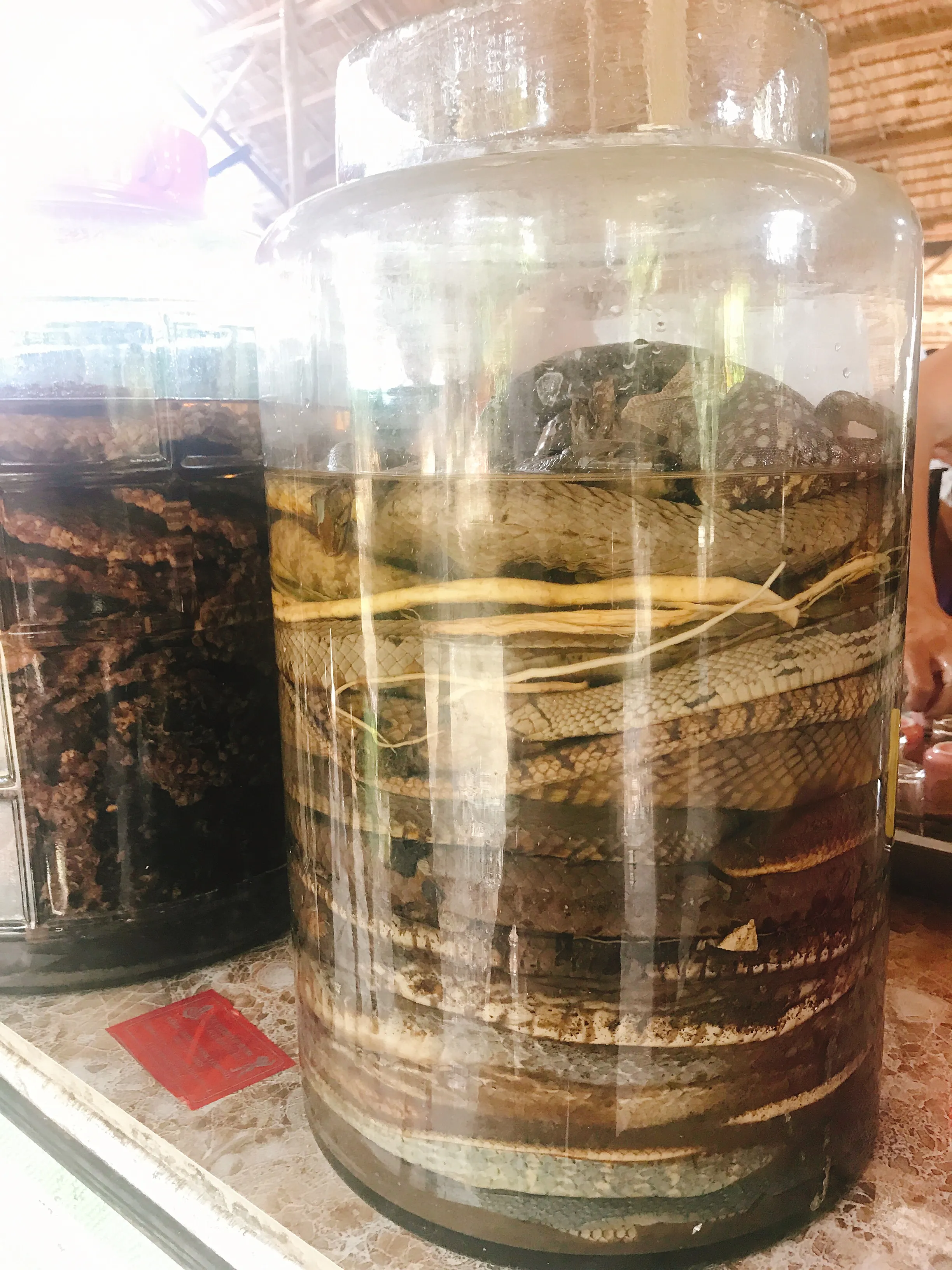 Traditional snake wine on display in the Mekong Delta
Traditional snake wine on display in the Mekong Delta
For further reading on this part of the trip, you can find detailed experiences in blog posts like the one linked in the original source. It highlights the contrast between city life and the peaceful rhythm of the delta.
Day 4: Travel from Ho Chi Minh City to Siem Reap
Today is a travel day, transitioning from Vietnam to Cambodia. The most common and budget-friendly way to travel between Ho Chi Minh City and Siem Reap is by bus. Several companies operate this route, offering varying levels of comfort and service. It’s a long journey, typically taking around 12-14 hours, including border crossings.
Booking in advance with a reputable company like Mekong Express can ensure a smoother experience. The bus ride takes you through changing landscapes, offering glimpses of rural life in both countries. The border crossing involves disembarking the bus, going through immigration procedures for both exiting Vietnam and entering Cambodia (visa requirements should be checked beforehand), and then re-boarding.
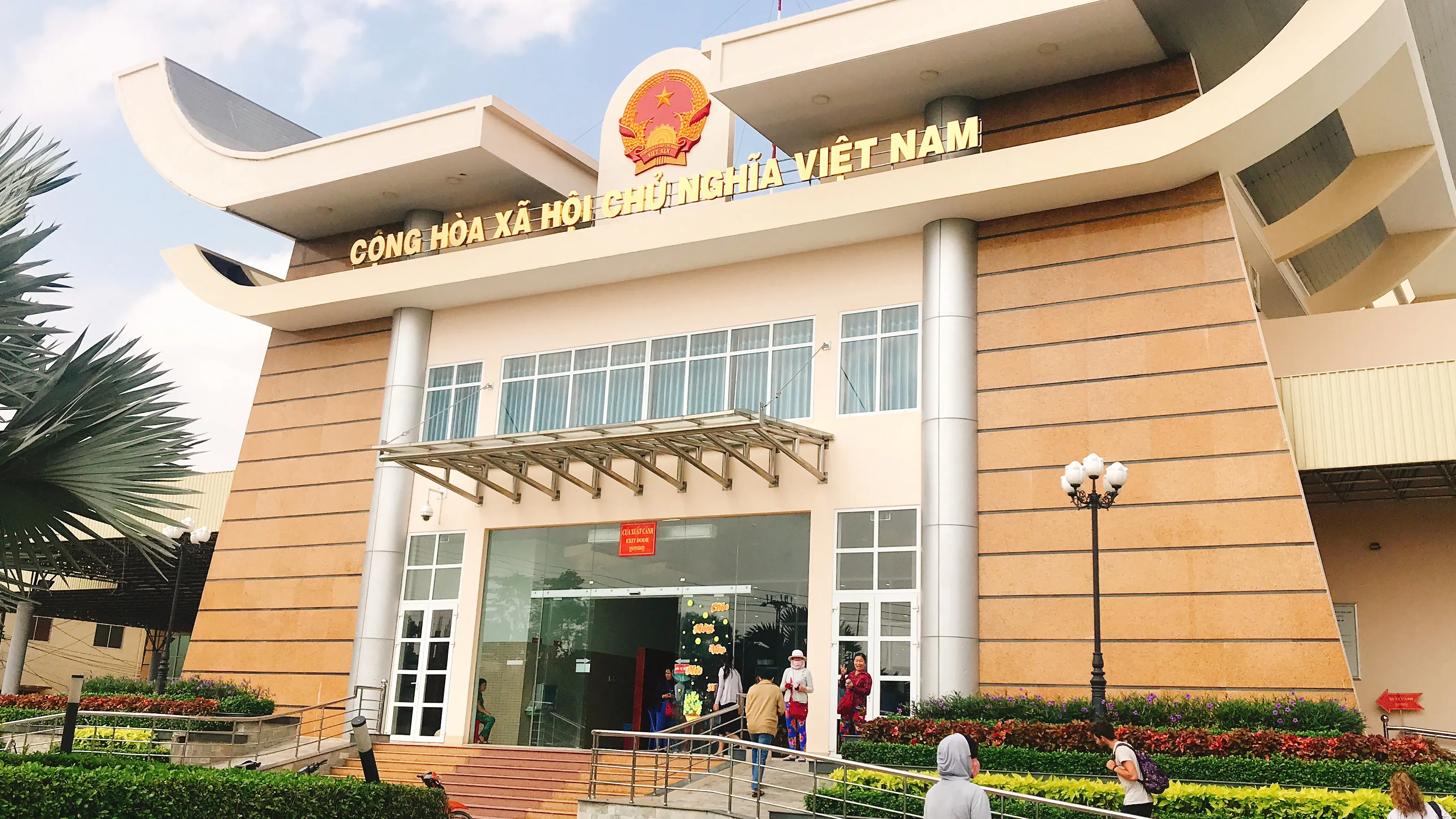 Sign marking the border crossing point between Vietnam and Cambodia
Sign marking the border crossing point between Vietnam and Cambodia
Upon arrival in Siem Reap in the evening, head straight to your accommodation to settle in. Siem Reap is the gateway to the Angkor Archaeological Park. After a long travel day, a visit to Pub Street is a great way to unwind, find dinner, and experience the town’s lively evening scene. Pub Street is packed with restaurants, bars, and street food vendors, catering specifically to travelers.
This travel day is a practical necessity for Backpacking Thailand Vietnam Cambodia by land, offering a glimpse into regional transportation and the administrative process of crossing international borders in Southeast Asia. For comprehensive details on this border crossing, consult resources like “Crossing border from Vietnam (Ho Chi Minh) to Cambodia (Siem Reap) via bus” mentioned in the original text.
Day 5: Siem Reap Temple Hopping (Angkor Wat & Beyond)
Day five is the highlight of the Cambodia portion of your trip: exploring the magnificent temples of the Angkor Archaeological Park. This UNESCO World Heritage site is vast, and requires an entrance pass (available for 1, 3, or 7 days). A common approach is to hire a tuk-tuk driver for the day, who can guide you through the “Small Circuit” and “Grand Circuit,” hitting the major temples efficiently.
Starting the day early is highly recommended, especially to witness the sunrise over Angkor Wat, the most iconic temple. Arriving before dawn allows you to secure a spot and watch as the sun’s first rays illuminate the ancient towers. It’s a truly magical and unforgettable experience, central to the cultural heart of Backpacking Thailand Vietnam Cambodia.
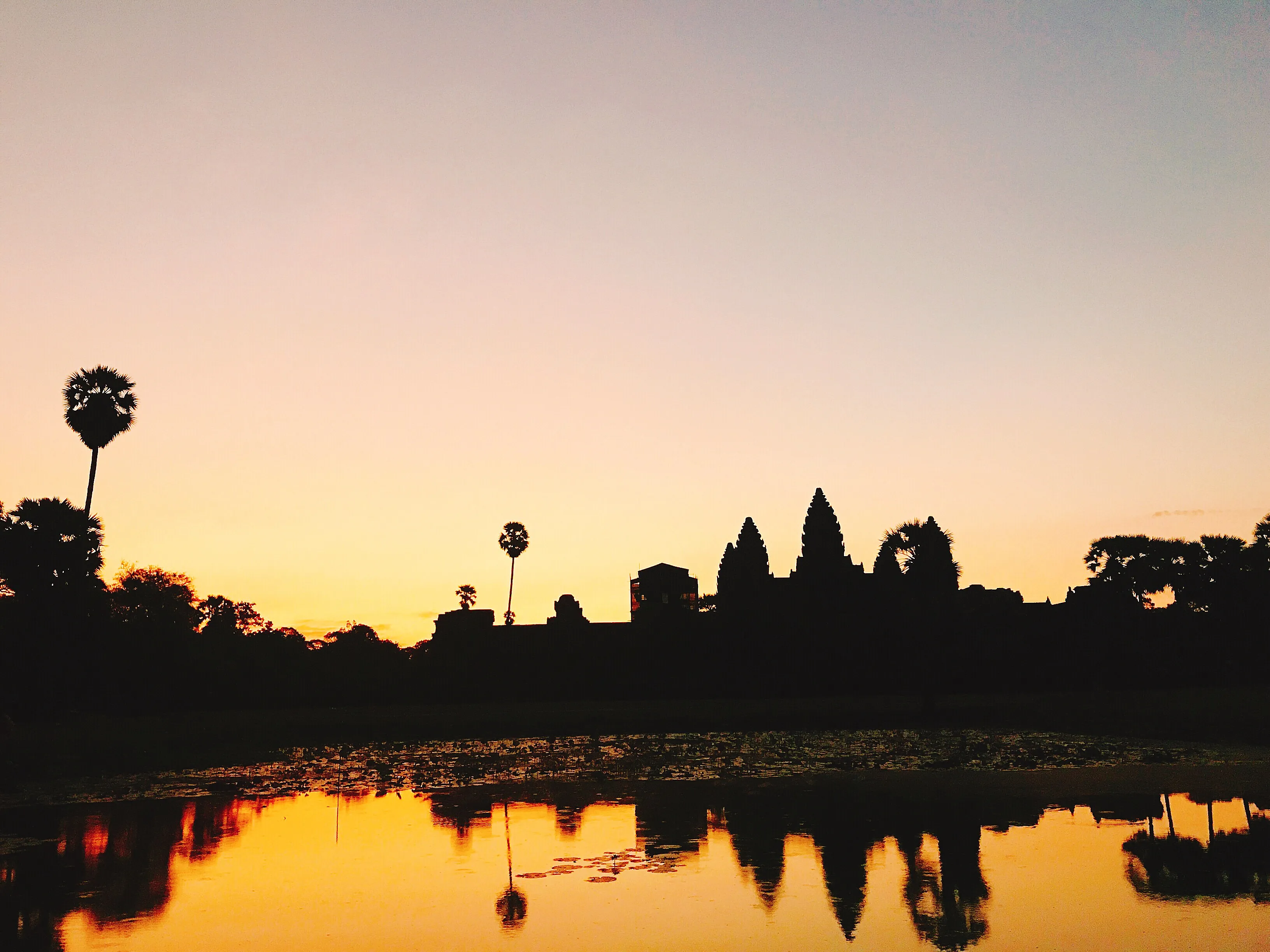 Capturing sunrise over the ancient towers of Angkor Wat, Cambodia
Capturing sunrise over the ancient towers of Angkor Wat, Cambodia
After sunrise, explore Angkor Wat itself, marveling at its intricate carvings and grand scale. Then, continue temple hopping. Must-sees include Bayon Temple, famous for its serene stone faces, and Ta Prohm, where giant tree roots entwine with ancient stones, giving it a mystical, “Tomb Raider” feel. Other notable stops on the circuit include Baphuon, the Royal Enclosure, and the Terraces of the Elephants.
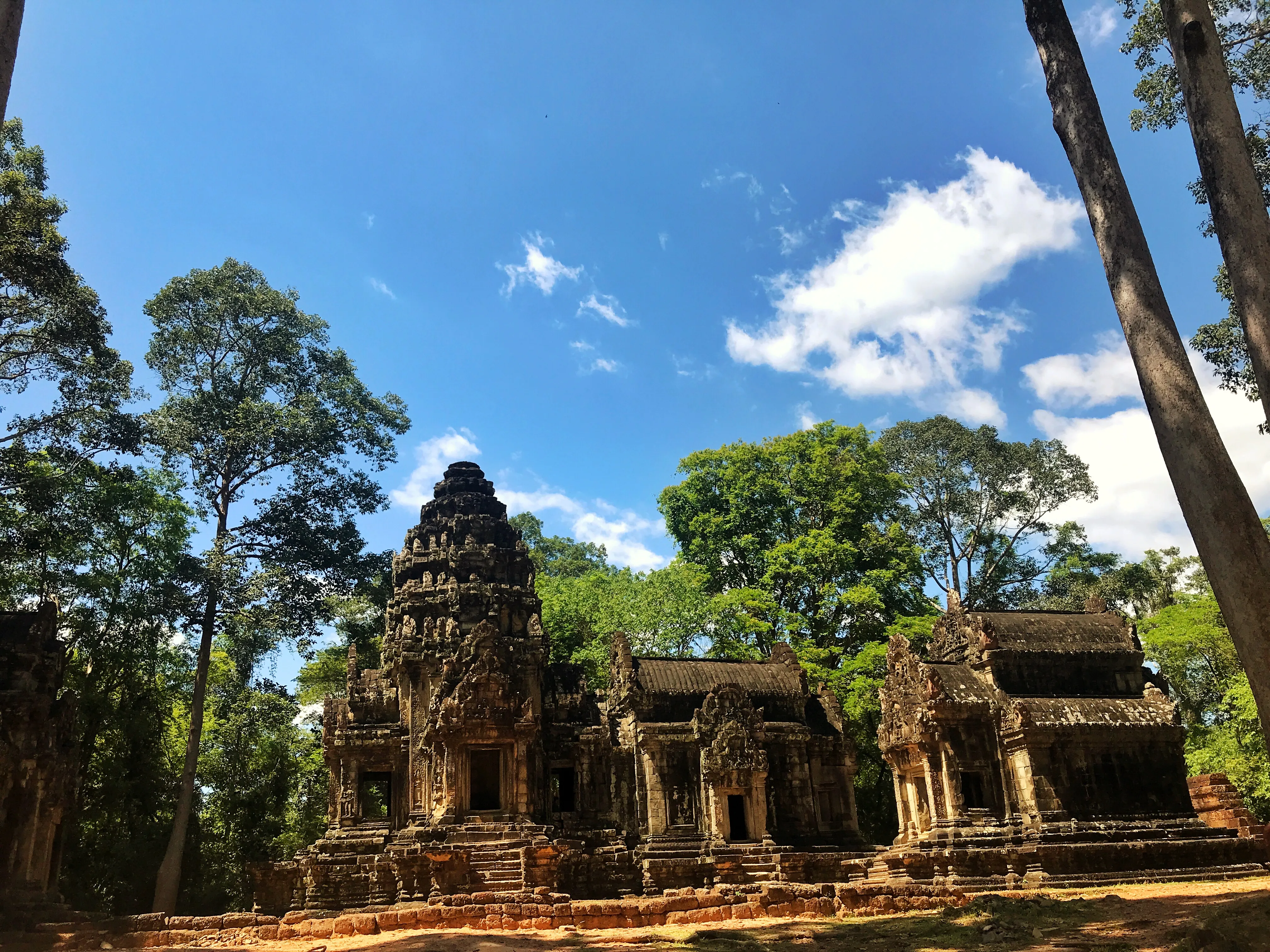 Tree roots embracing ancient temple ruins at Ta Prohm, Cambodia
Tree roots embracing ancient temple ruins at Ta Prohm, Cambodia
Visiting the Angkor National Museum can provide valuable context before or after seeing the temples. Consider ending the day with a sunset view from a temple like Phnom Bakheng (be aware of crowds and access restrictions). A full day of temple exploration is physically demanding but incredibly rewarding, offering deep historical and spiritual insights.
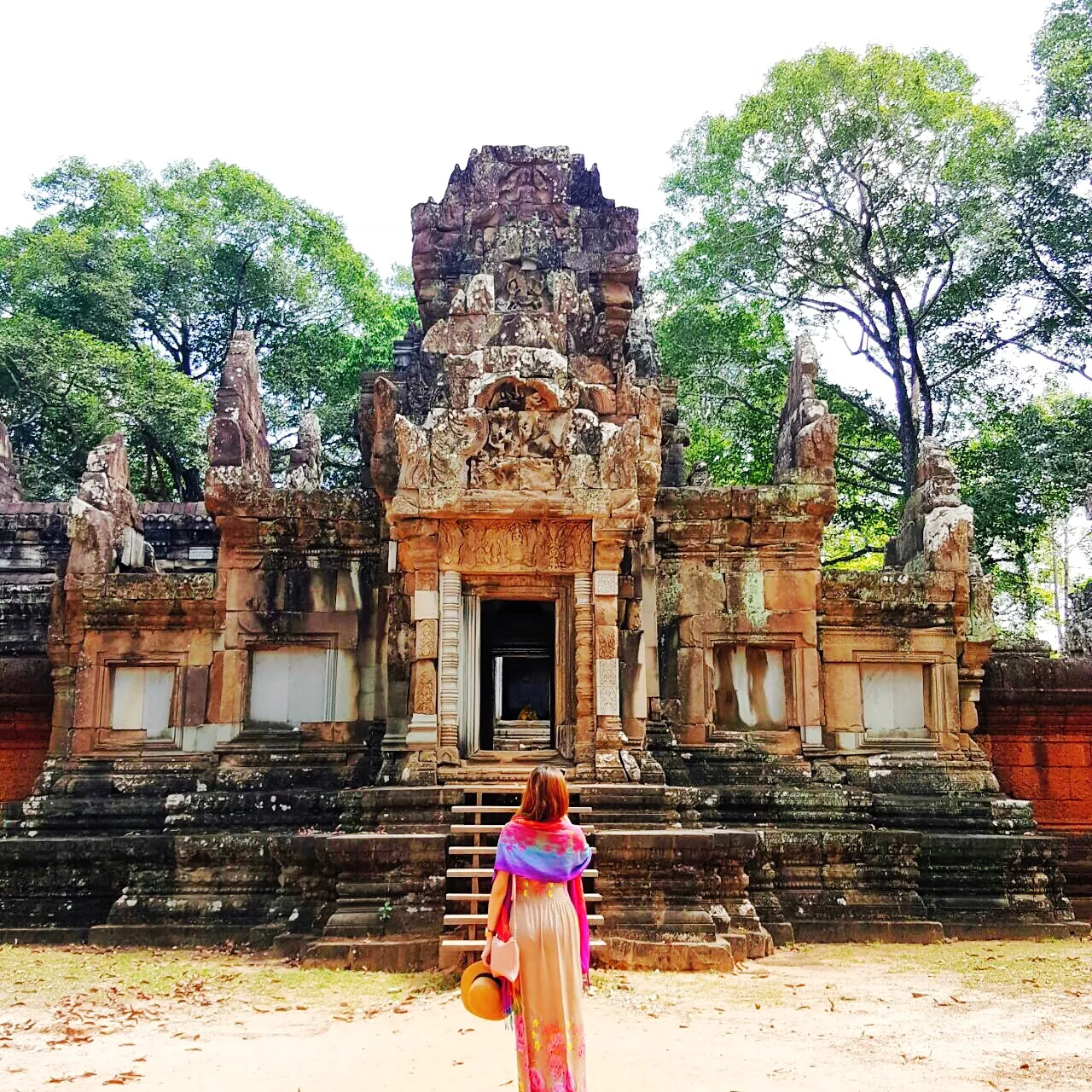 Intricate carvings on an ancient temple wall in Siem Reap, Cambodia
Intricate carvings on an ancient temple wall in Siem Reap, Cambodia
For a detailed plan for your time in Siem Reap, refer to resources such as “Temple Run in Siem Reap, Cambodia (Full Itinerary guide for 3D/2N)”. Experiencing Angkor Wat is a cornerstone of Backpacking Thailand Vietnam Cambodia, connecting you to an ancient empire’s legacy.
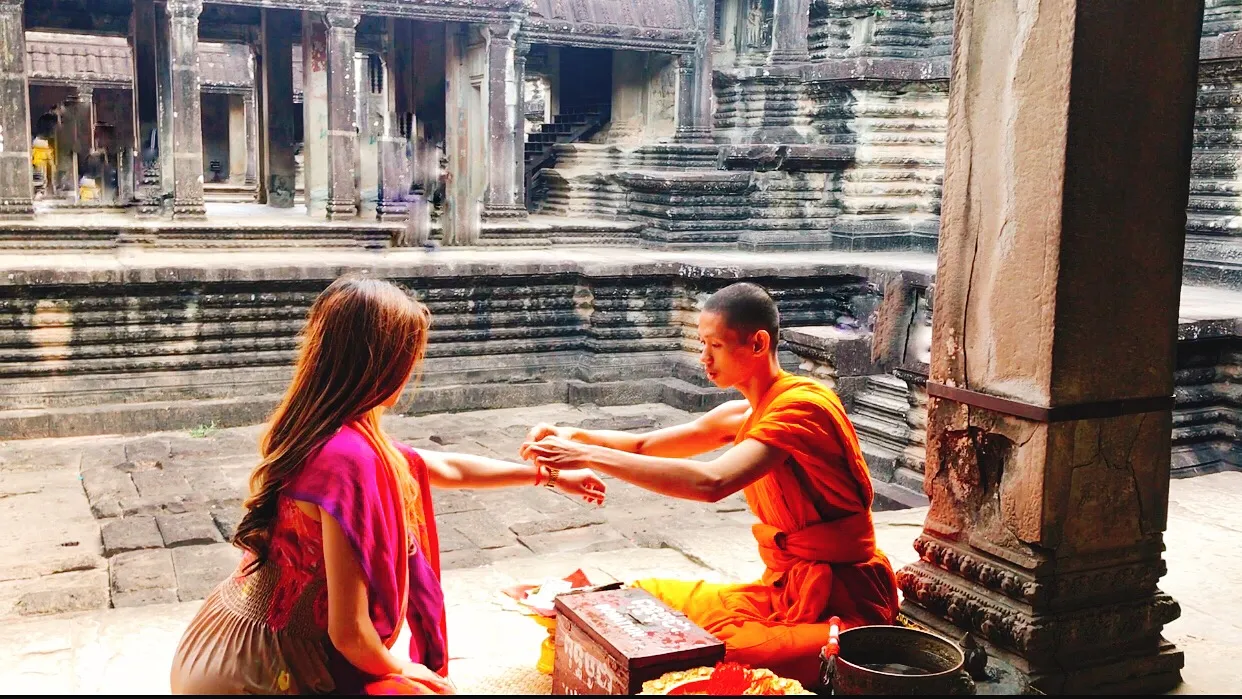 Receiving a blessing from a Buddhist monk near Angkor Wat, Cambodia
Receiving a blessing from a Buddhist monk near Angkor Wat, Cambodia
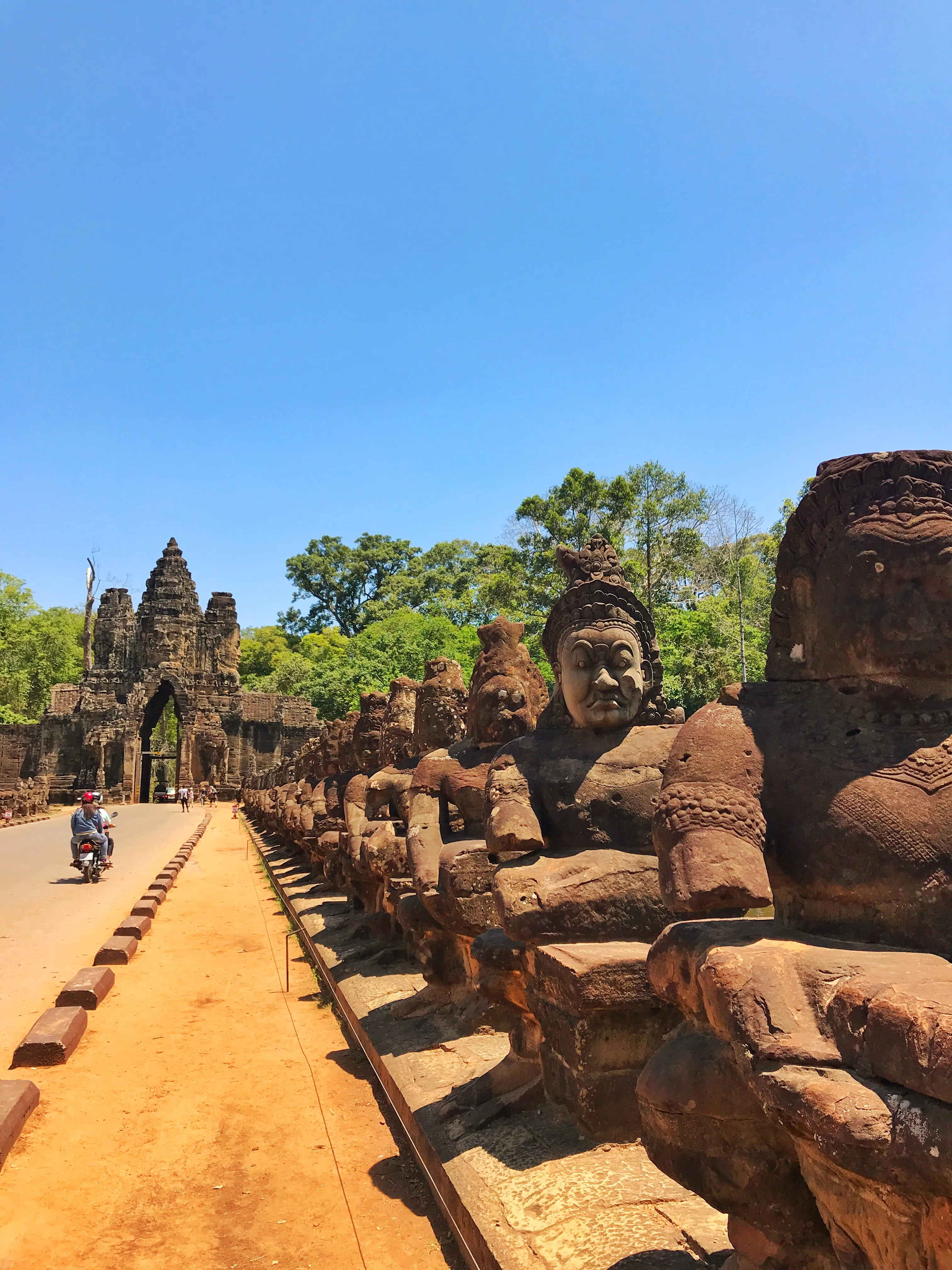 Exploring the historic architecture of a temple complex in Siem Reap
Exploring the historic architecture of a temple complex in Siem Reap
Day 6: Travel from Siem Reap to Bangkok to Chiang Mai
Another significant travel day as you move from Cambodia into Thailand, and then potentially onwards to Chiang Mai. The most common way to get from Siem Reap to Bangkok is also by bus. This journey is shorter than the Vietnam-Cambodia leg, typically taking around 8-9 hours, including the border crossing at Poipet/Aranyaprathet.
Booking with a reliable bus company is advisable for comfort and efficiency. Crossing the border into Thailand involves navigating the procedures, which can sometimes be busy. Once in Bangkok, you’ll likely arrive at one of the major bus terminals.
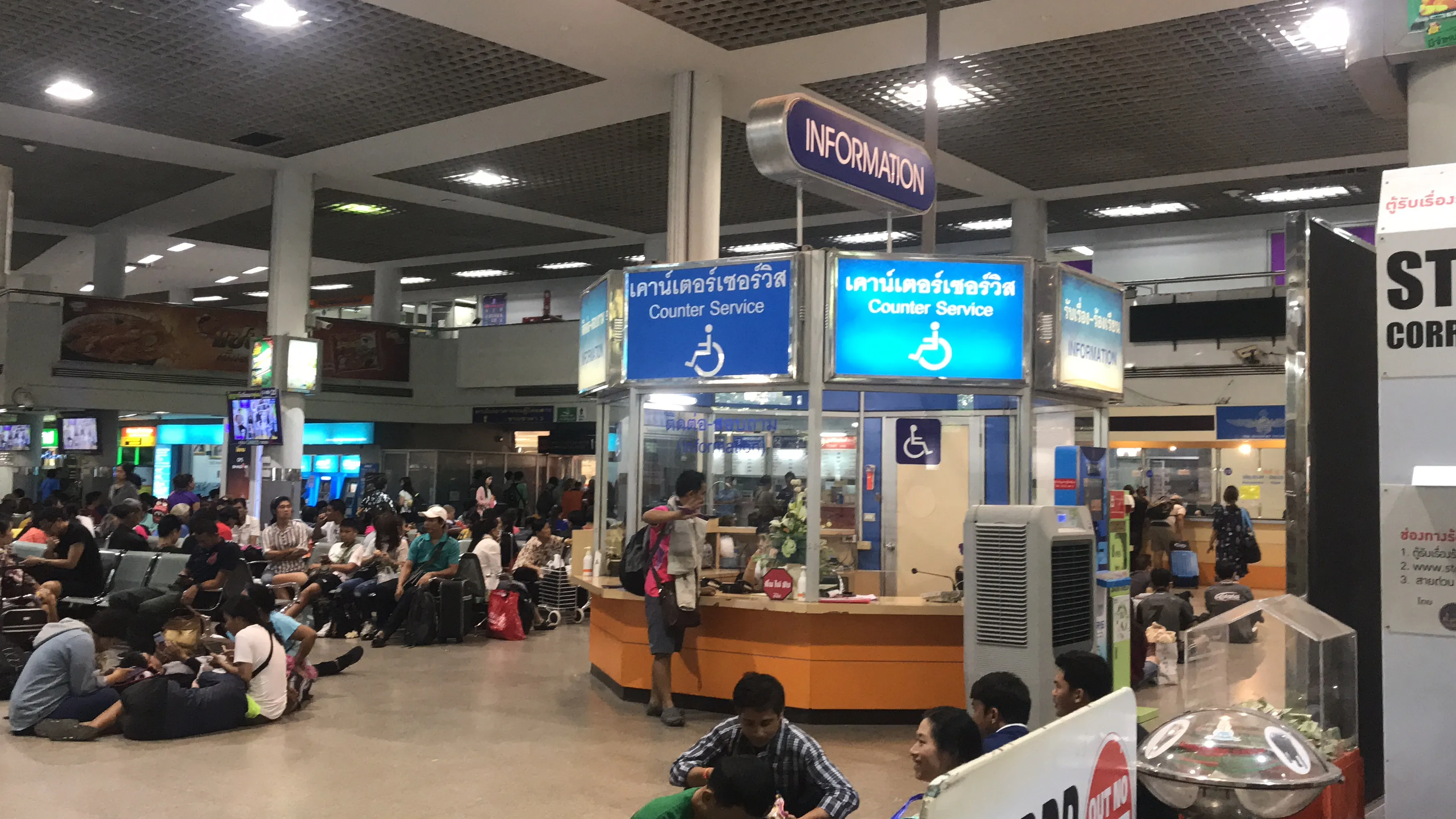 Bus terminal in Bangkok for transport to Chiang Mai
Bus terminal in Bangkok for transport to Chiang Mai
If you’re on a shorter trip (7 days), you might spend your remaining time exploring Bangkok. However, for a longer adventure like the 11-day plan described here, the next step is traveling north to Chiang Mai. The most time-efficient way is usually an overnight bus or train. Sleeper buses are a popular choice for backpackers, saving on accommodation costs and maximizing daylight hours for sightseeing.
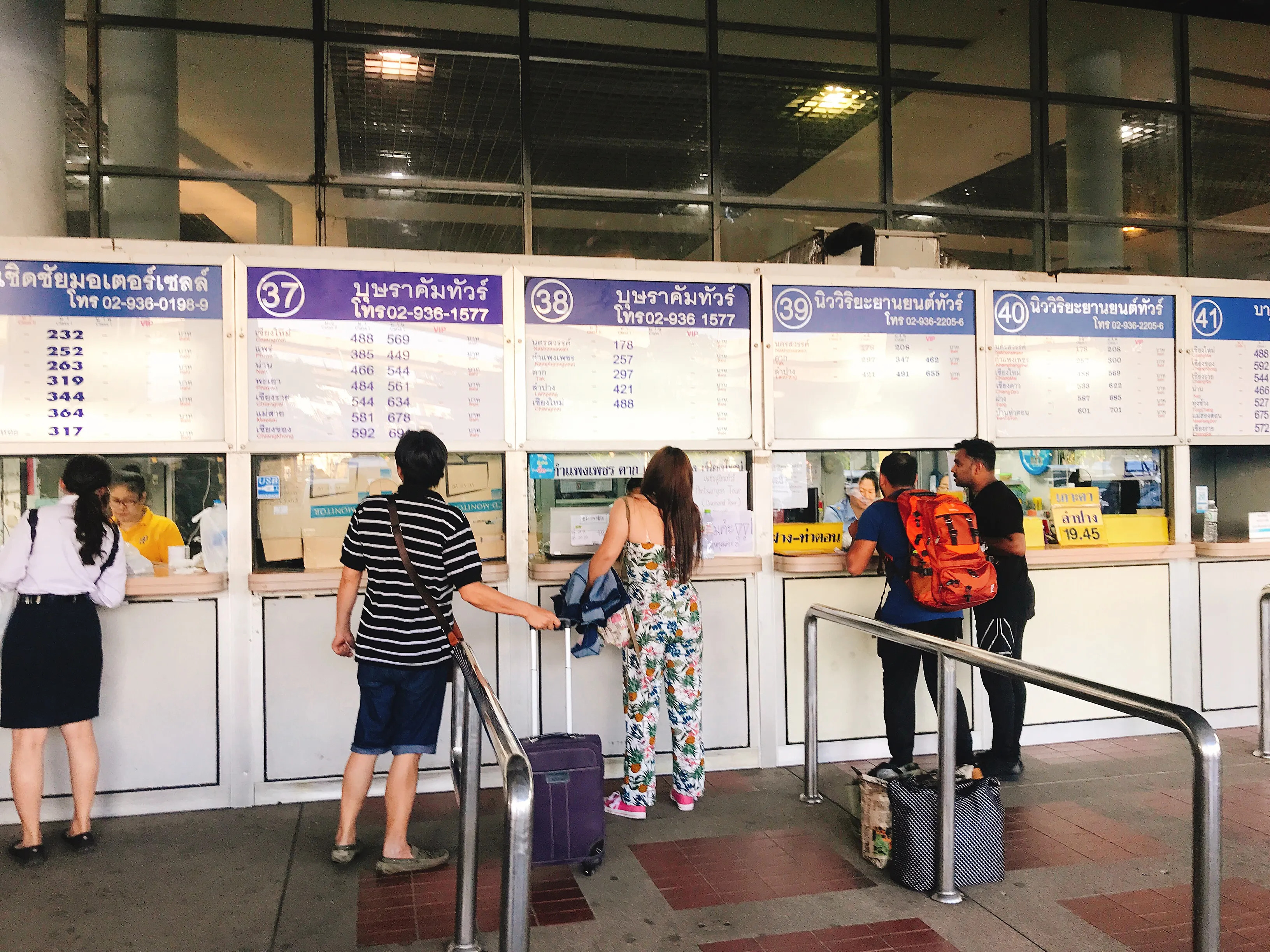 Interior of an overnight sleeper bus from Bangkok to Chiang Mai
Interior of an overnight sleeper bus from Bangkok to Chiang Mai
Catching an evening sleeper bus from Bangkok allows you to arrive in Chiang Mai early the next morning. This day is primarily focused on transportation logistics, a necessary part of covering ground while Backpacking Thailand Vietnam Cambodia on a budget. Detailed guides on these border crossings and travel between Bangkok and Chiang Mai are available online.
Day 7: Arrival in Chiang Mai & City Exploration
Arrive in the northern city of Chiang Mai in the morning, a welcome change of pace from the bustling metropolises. Chiang Mai has a more laid-back, spiritual, and cultural vibe, surrounded by mountains and home to hundreds of Buddhist temples. Check into your accommodation – Chiang Mai has numerous excellent hostels and guesthouses catering to backpackers.
After freshening up and grabbing breakfast (places like Amaka Cafe are popular), it’s time to explore the city. Chiang Mai’s old city is contained within ancient walls and a moat, making it easy to navigate on foot, by bicycle, or by ‘red taxi’ (songthaew).
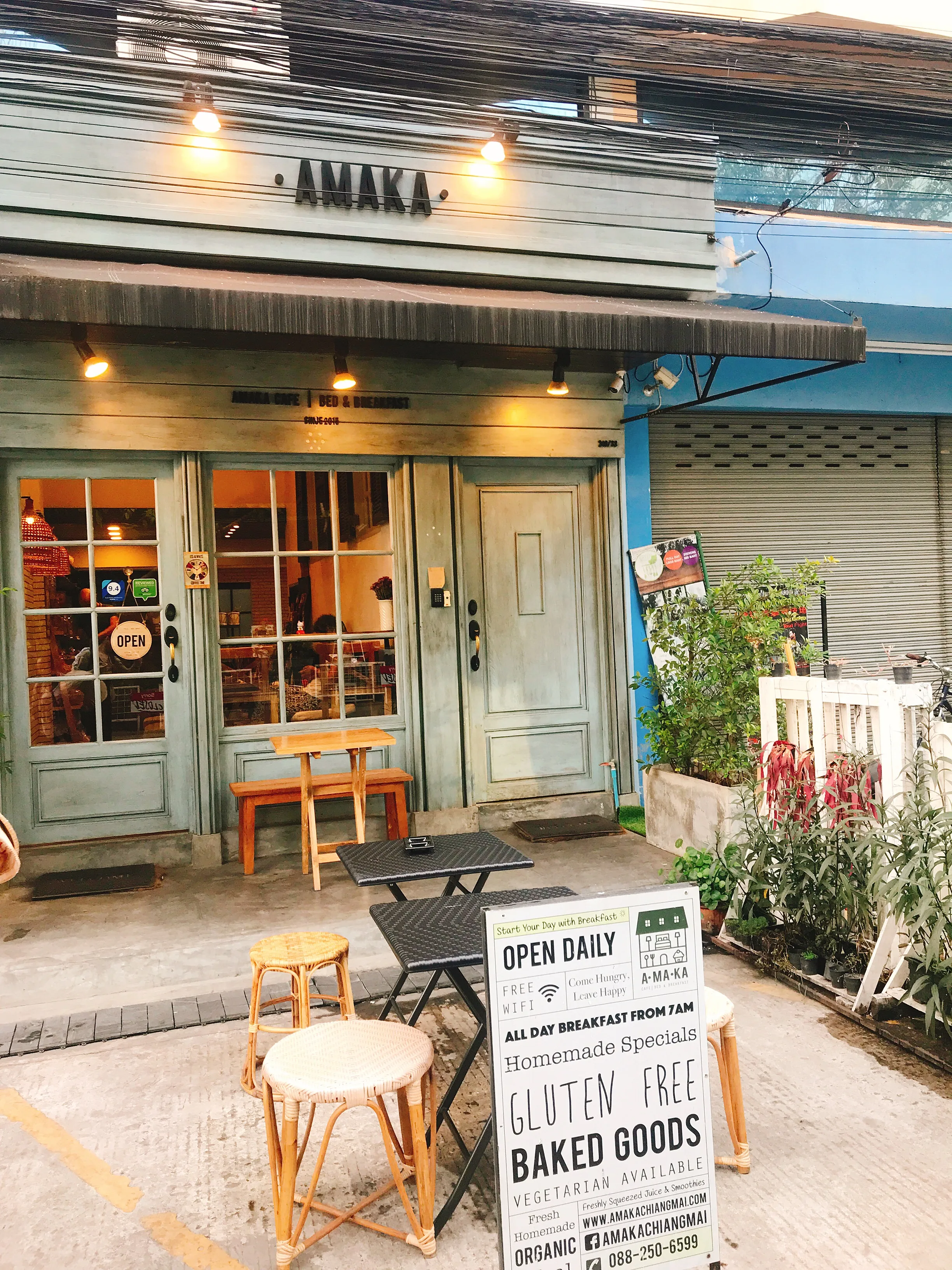 Breakfast served at Amaka Cafe in Chiang Mai
Breakfast served at Amaka Cafe in Chiang Mai
Spend the day visiting some of the city’s most significant temples, such as Wat Phra Singh, Wat Chedi Luang, and Wat Phan Tao. Each temple has its own unique architecture and history. Exploring these sacred sites provides insight into Thai Buddhism and the region’s spiritual practices, enriching your Backpacking Thailand Vietnam Cambodia experience.
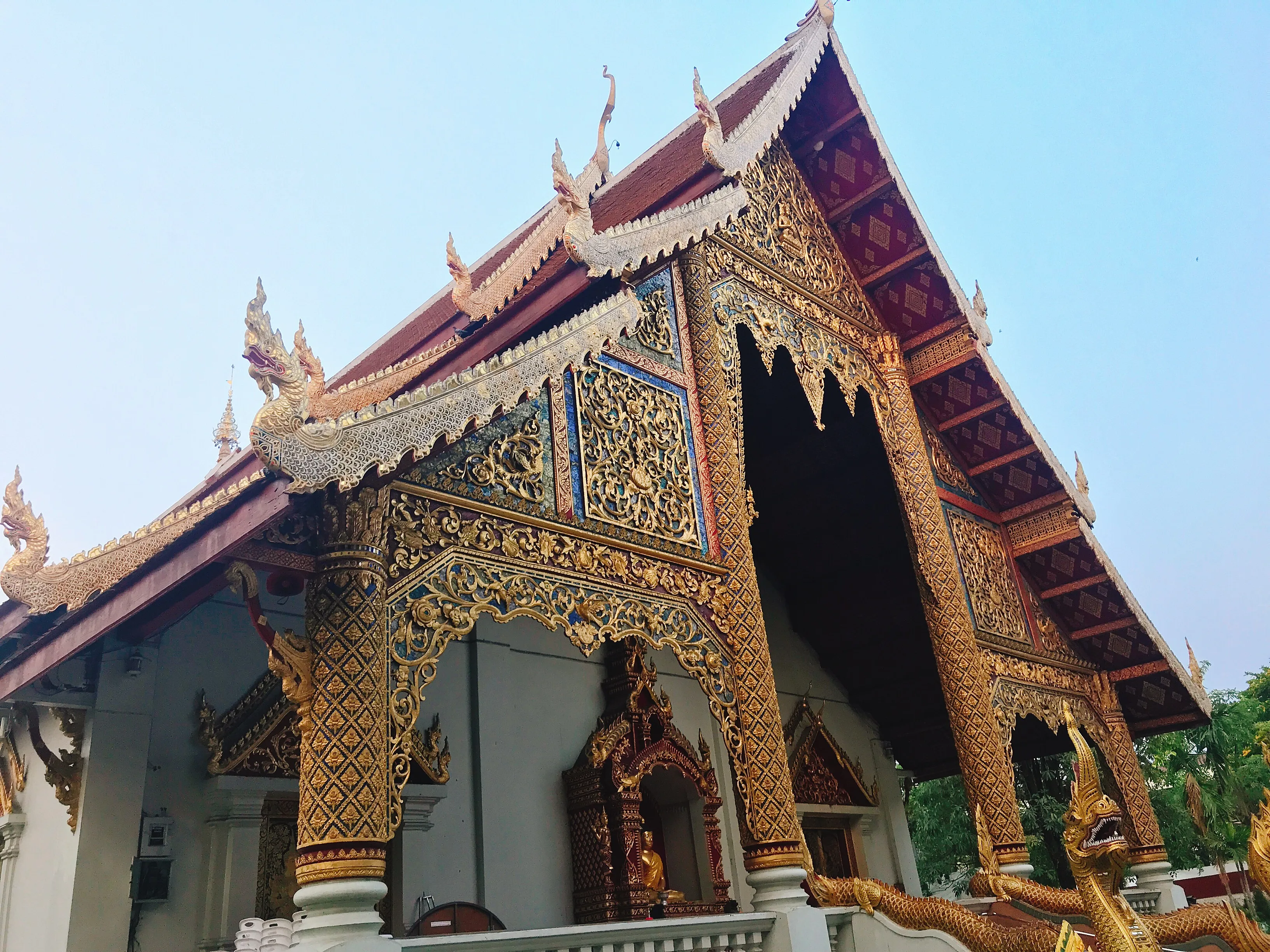 Ancient temples nestled within the city of Chiang Mai, Thailand
Ancient temples nestled within the city of Chiang Mai, Thailand
Depending on your interests, you could also venture slightly outside the city to unique spots like “The Giant,” a large treehouse cafe. The evening can be spent exploring the night markets (especially the Sunday Walking Street Market if it aligns with your visit) and trying Northern Thai cuisine like Khao Soi. Chiang Mai offers a different perspective on Thailand, focusing on culture and nature.
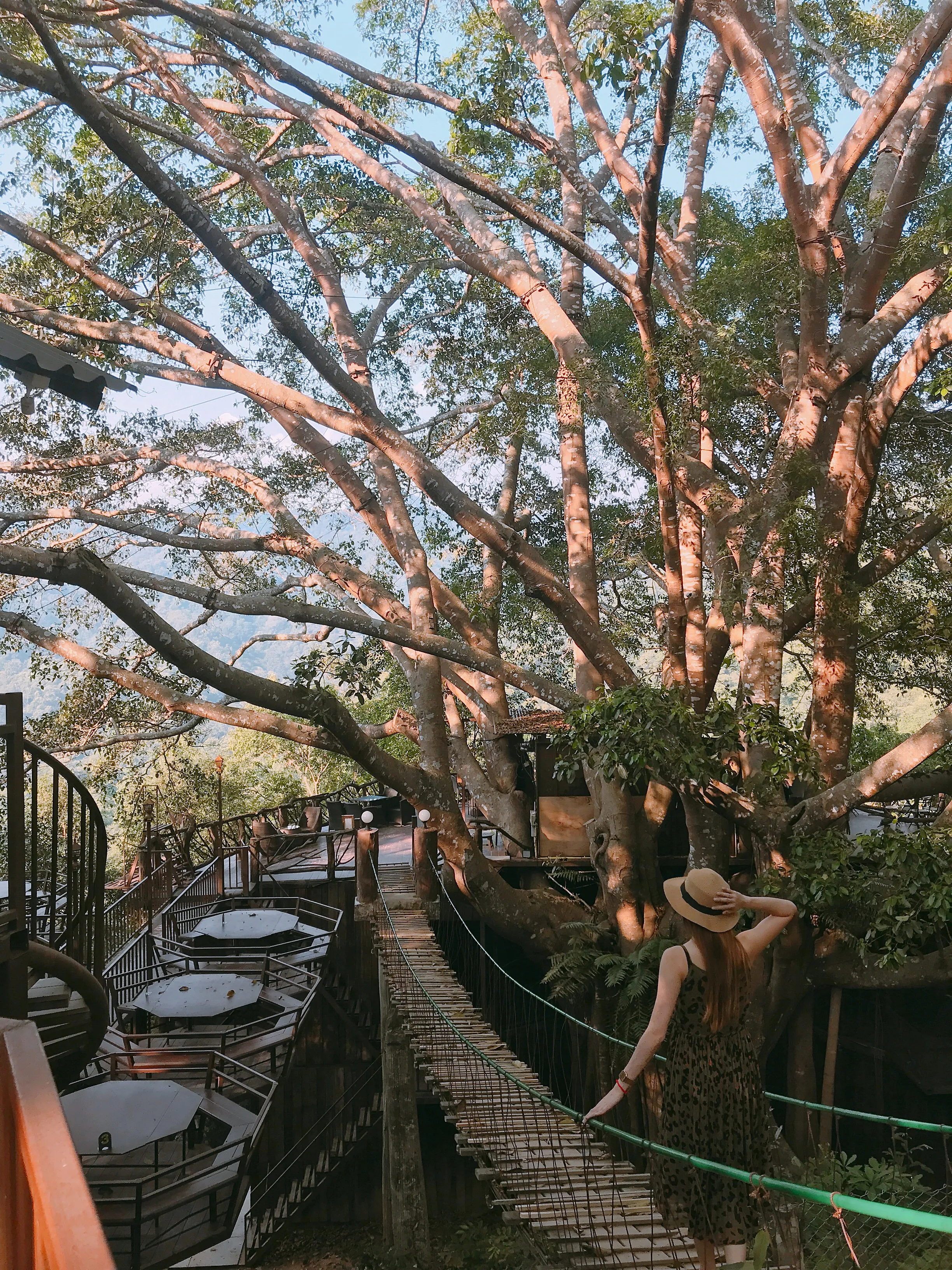 The Giant Treehouse cafe attraction near Chiang Mai
The Giant Treehouse cafe attraction near Chiang Mai
You can find more detailed itineraries for Chiang Mai in resources like “Chiang Mai Travel Guide : 4D/3N Itinerary, Activities, Budget”, which can help you tailor your exploration of this charming city.
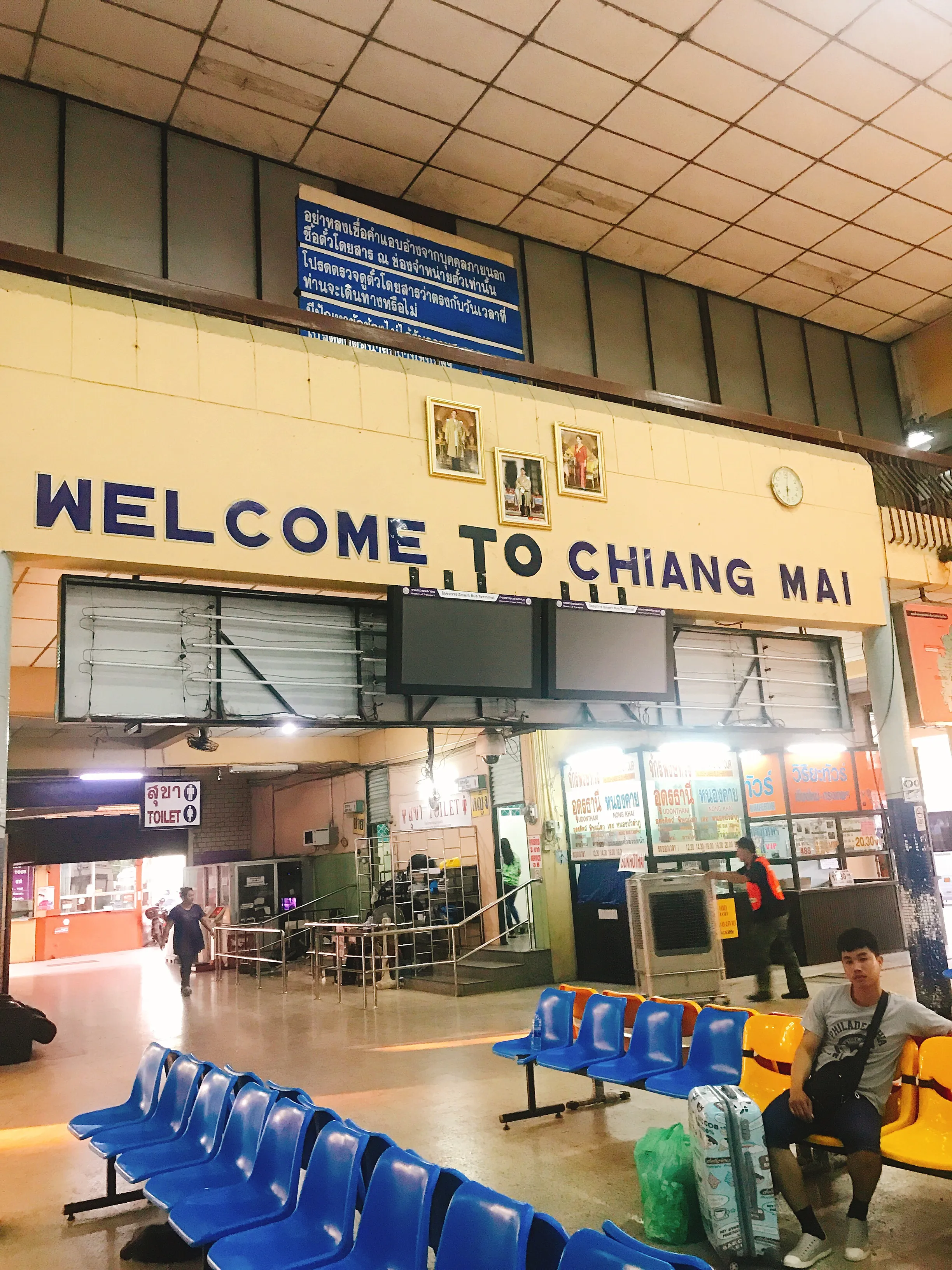 Welcome to Chiang Mai sign, Thailand
Welcome to Chiang Mai sign, Thailand
Day 8: Ethical Elephant Sanctuary Experience
One of the most memorable and meaningful experiences in Chiang Mai is visiting an ethical elephant sanctuary. It’s crucial to choose a sanctuary that prioritizes the well-being of the elephants, focusing on rescue, rehabilitation, and natural interaction rather than riding or performances. The “Elephant Jungle Sanctuary” is one such example that promotes responsible tourism.
A typical half-day or full-day visit involves learning about the elephants’ history and conservation efforts. You’ll have the opportunity to feed them, walk with them in their natural environment, and participate in bathing them in a river or mud bath. This hands-on experience allows for close interaction while respecting the animals’ needs.
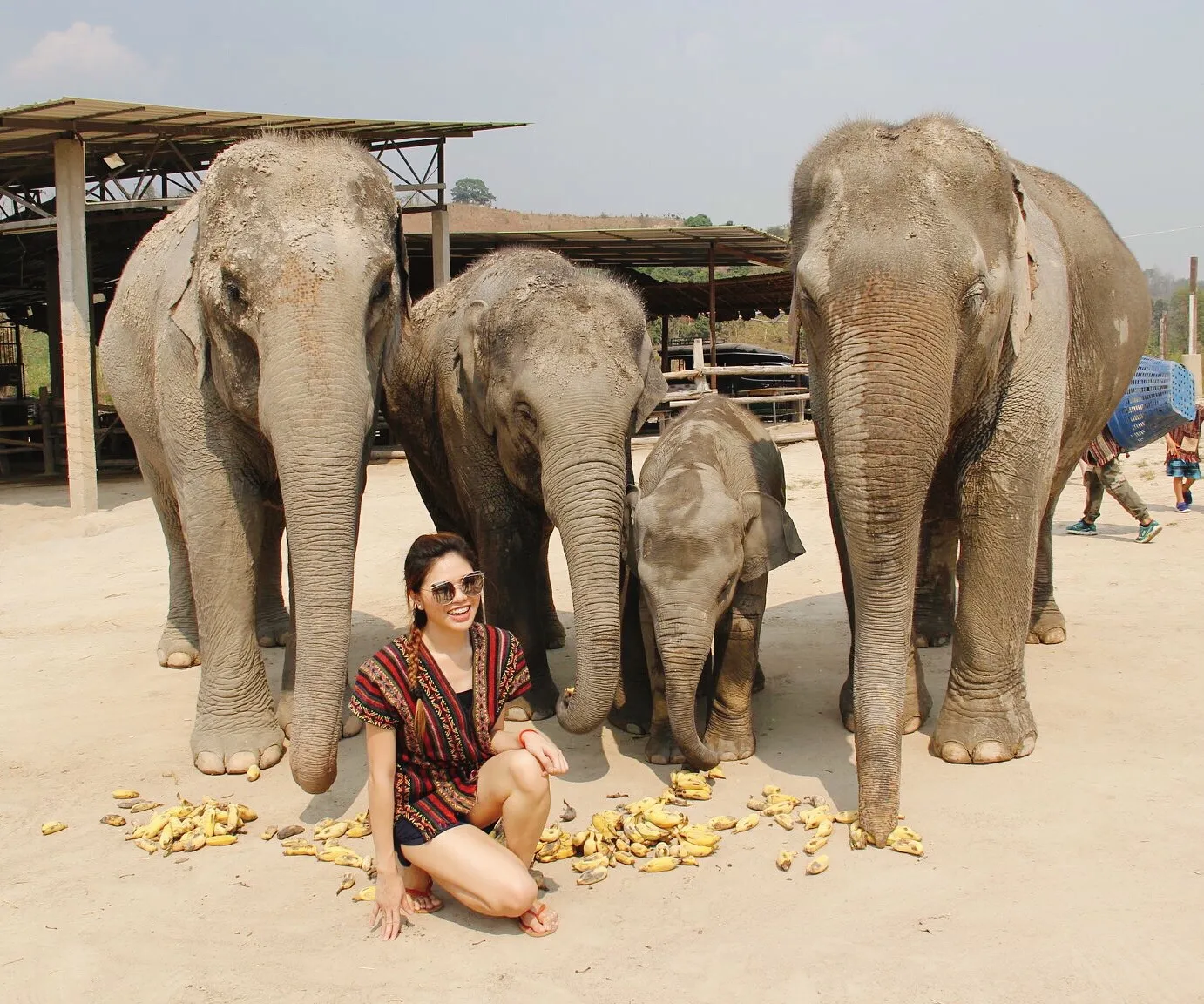 Elephants walking freely at the Elephant Jungle Sanctuary near Chiang Mai
Elephants walking freely at the Elephant Jungle Sanctuary near Chiang Mai
Responsible tourism around elephants is a key message promoted by ethical sanctuaries. Supporting operations that advocate “NO TO ELEPHANT RIDING!” helps ensure these magnificent creatures are treated with care and respect. Participating in such an activity adds a layer of conscious travel to your Backpacking Thailand Vietnam Cambodia journey.
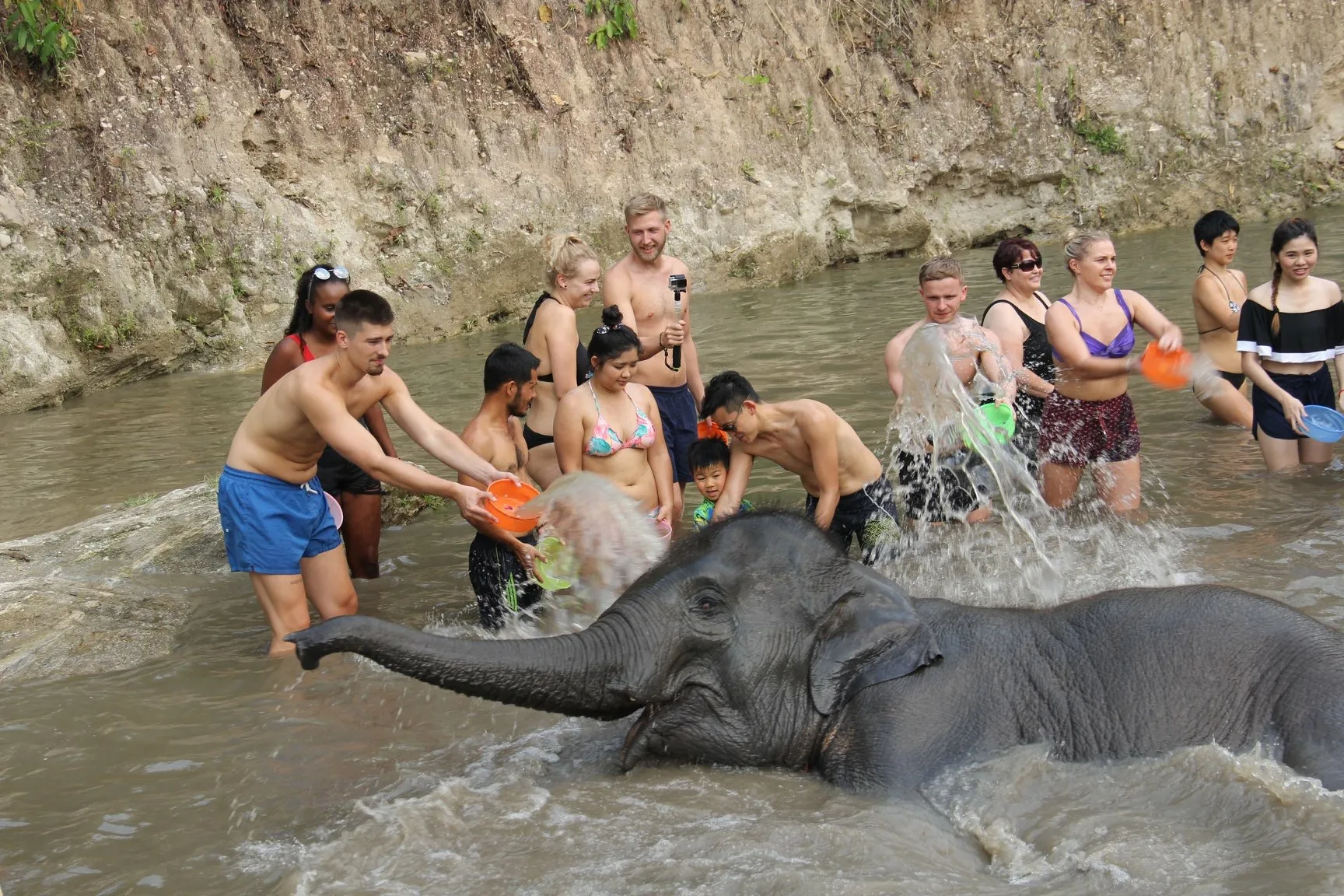 Interacting with a happy elephant at the sanctuary
Interacting with a happy elephant at the sanctuary
Lunch is usually provided at the sanctuary. The experience is not only fun but also educational, leaving you with a deeper appreciation for elephants and the importance of protecting them. It’s a must-do for animal lovers visiting Chiang Mai.
You can find more details on this experience and other Chiang Mai activities in comprehensive guides like the one linked previously, highlighting activities and budget considerations.
Day 9: Doi Inthanon National Park & Overnight Travel to Bangkok
Dedicate day nine to exploring the natural beauty surrounding Chiang Mai with a trip to Doi Inthanon National Park. Often referred to as “the Roof of Thailand,” it’s home to the country’s highest peak. A guided tour is a convenient way to visit the park’s highlights. Many tours can be booked through platforms like Klook.
The trip typically includes visits to impressive waterfalls like Wachiritham Waterfall, the beautiful King and Queen’s Chedis (twin pagodas built to commemorate royal birthdays), the summit of Doi Inthanon (marked with a sign), and a walk along the Angkha Nature Trail boardwalk through a cloud forest.
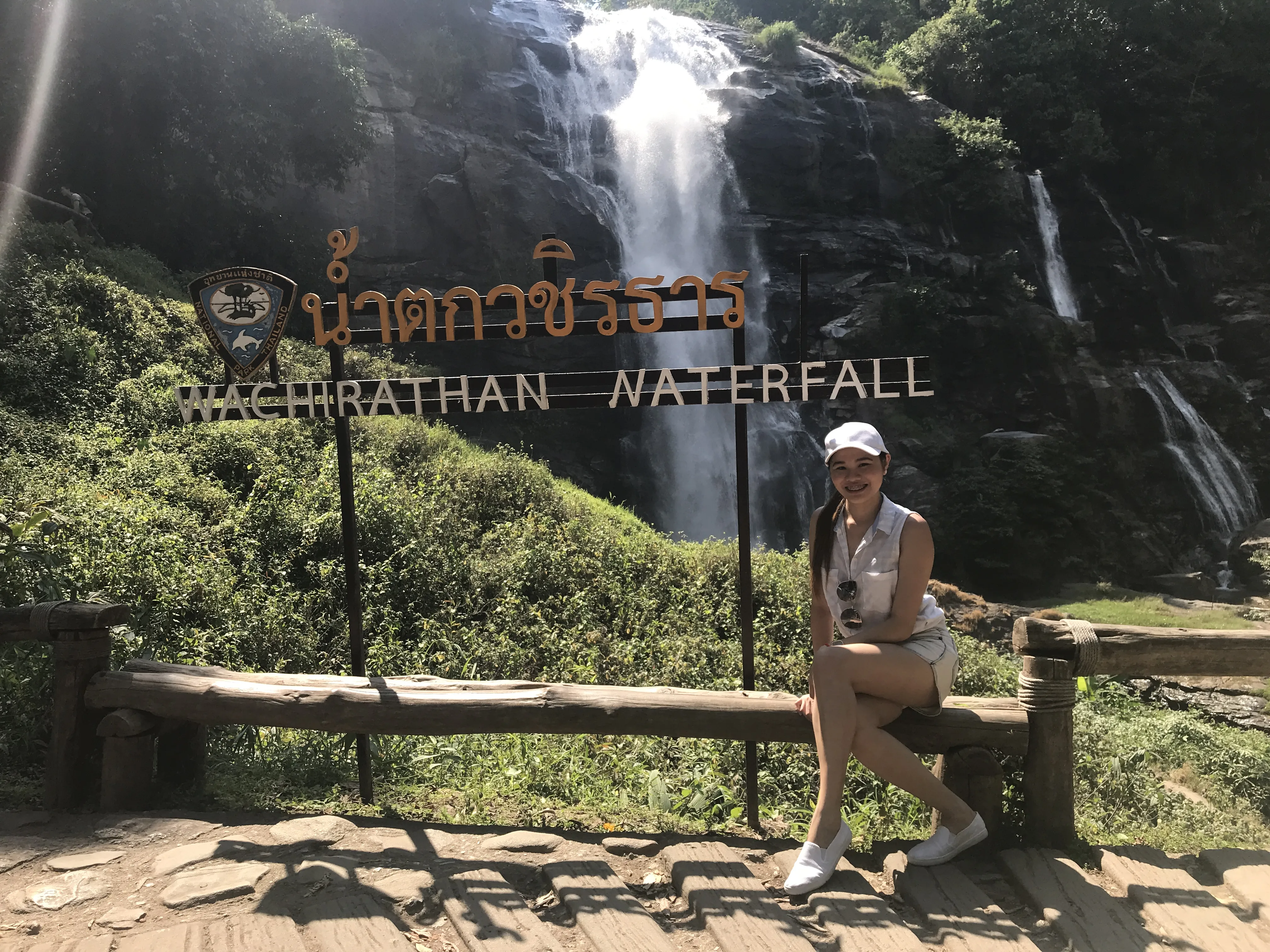 Wachiritham Waterfall, a stop on the Doi Inthanon trip
Wachiritham Waterfall, a stop on the Doi Inthanon trip
You might also visit the Royal Agricultural Station Inthanon, showcasing sustainable farming projects. These tours usually include transportation, park entrance fees, and lunch, making it an easy way to experience the park’s diverse ecosystems and cultural sites.
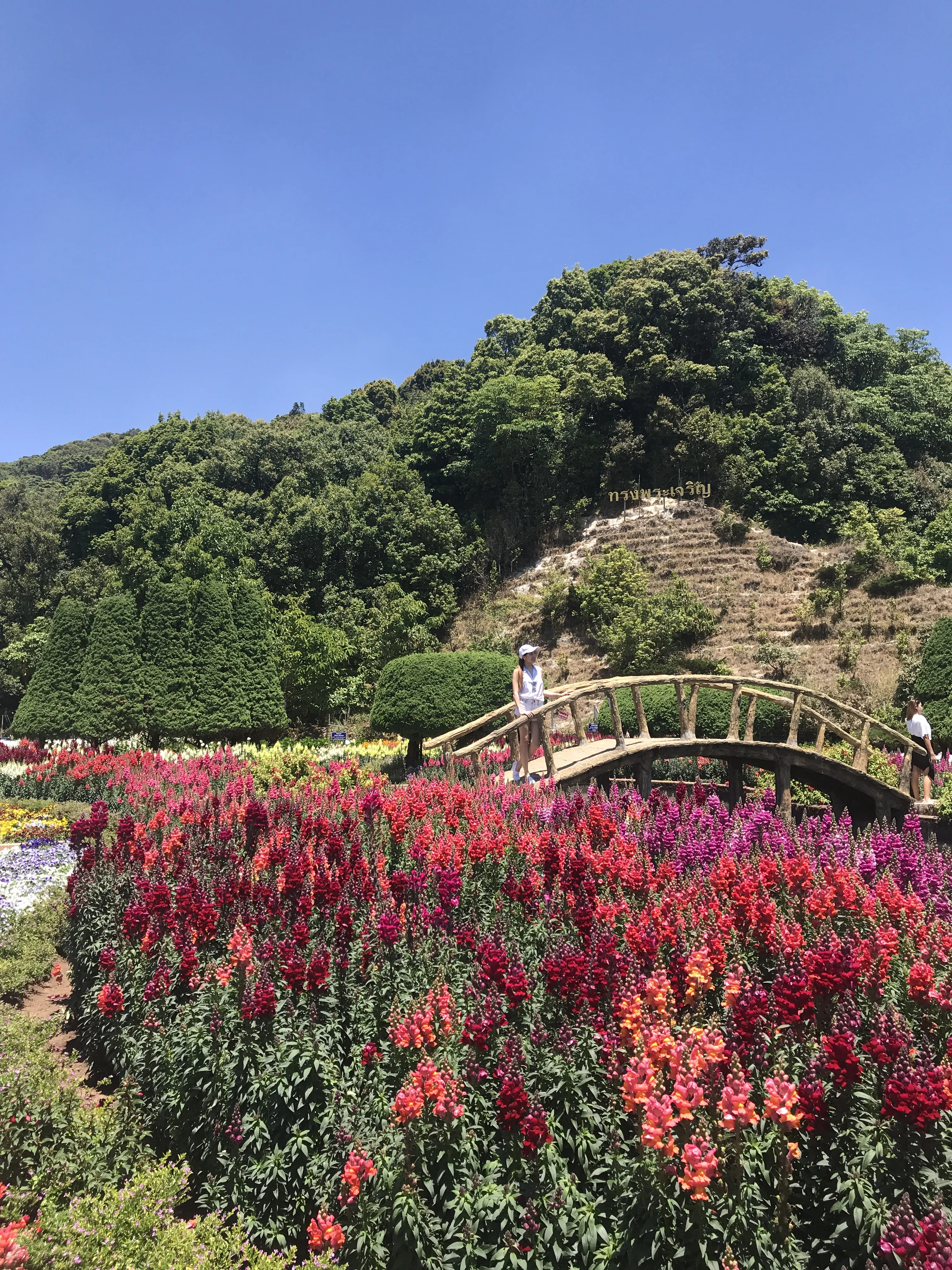 Beautiful gardens near the King and Queen’s Chedis at Doi Inthanon
Beautiful gardens near the King and Queen’s Chedis at Doi Inthanon
After returning to Chiang Mai from the park tour, retrieve your luggage from your accommodation (most hostels allow late check-out or luggage storage) and head back to the bus terminal for an overnight sleeper bus journey back to Bangkok. This efficient travel method allows you to wake up in the capital, ready for your final days of the trip.
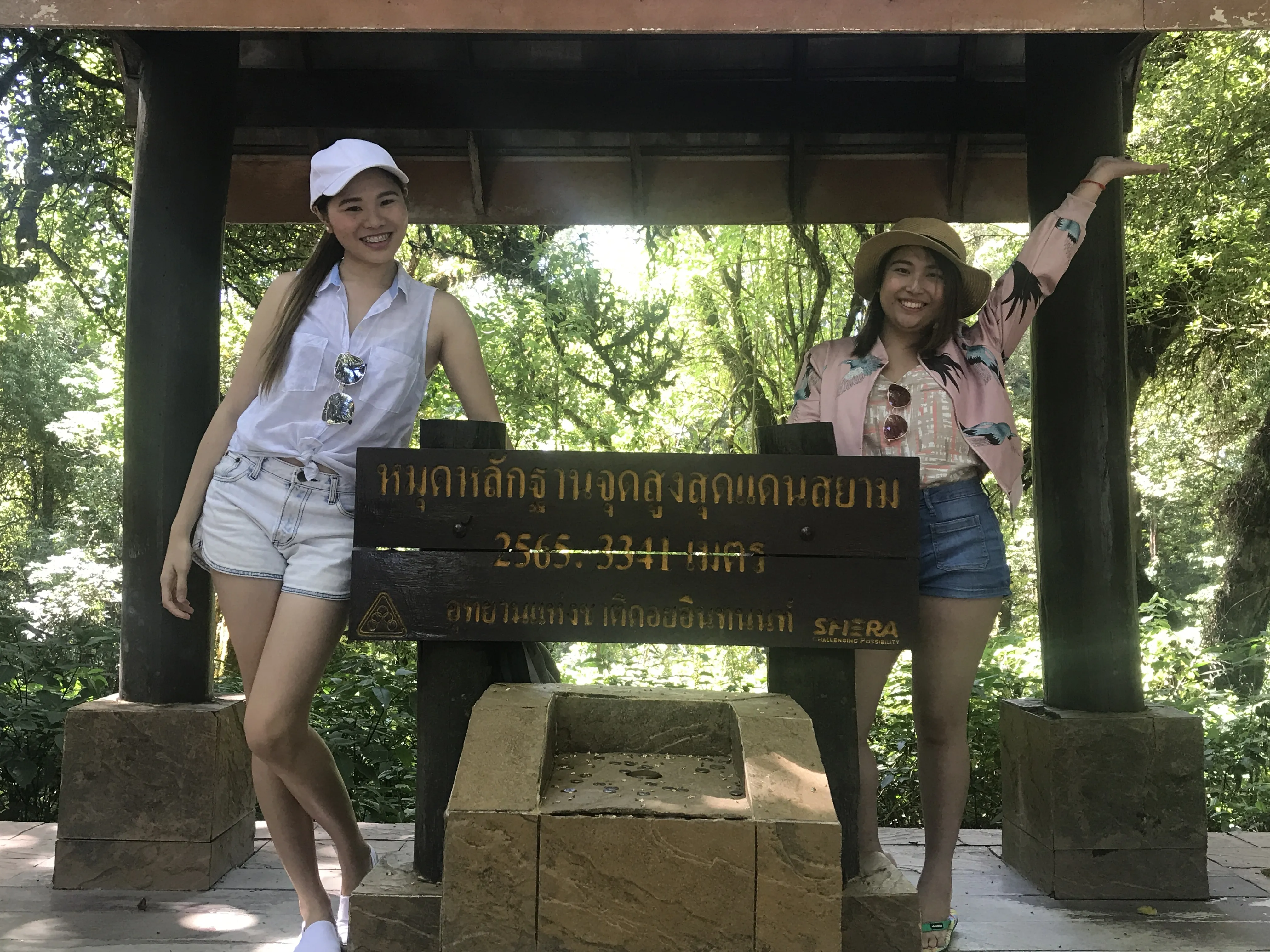 Sign marking the highest point in Thailand, Doi Inthanon
Sign marking the highest point in Thailand, Doi Inthanon
This day balances natural exploration with practical travel, crucial for maximizing your time while Backpacking Thailand Vietnam Cambodia. Additional details on the Doi Inthanon trip can be found in related travel guides for Chiang Mai.
Day 10: Bangkok Exploration & Songkran Festival (Seasonal)
Arrive back in Bangkok in the morning after your overnight bus from Chiang Mai. Check into your accommodation – Bangkok offers a huge range of options from budget hostels to boutique hotels. This day is dedicated to exploring the vibrant Thai capital.
If your visit coincides with mid-April, you might experience the Songkran Festival, the Thai New Year. It’s famous for being a massive water fight celebration held nationwide. If you’re in Bangkok during Songkran, be prepared to get wet! The streets turn into a lively playground with people splashing water at each other. It’s an exhilarating cultural experience, albeit a very wet one.
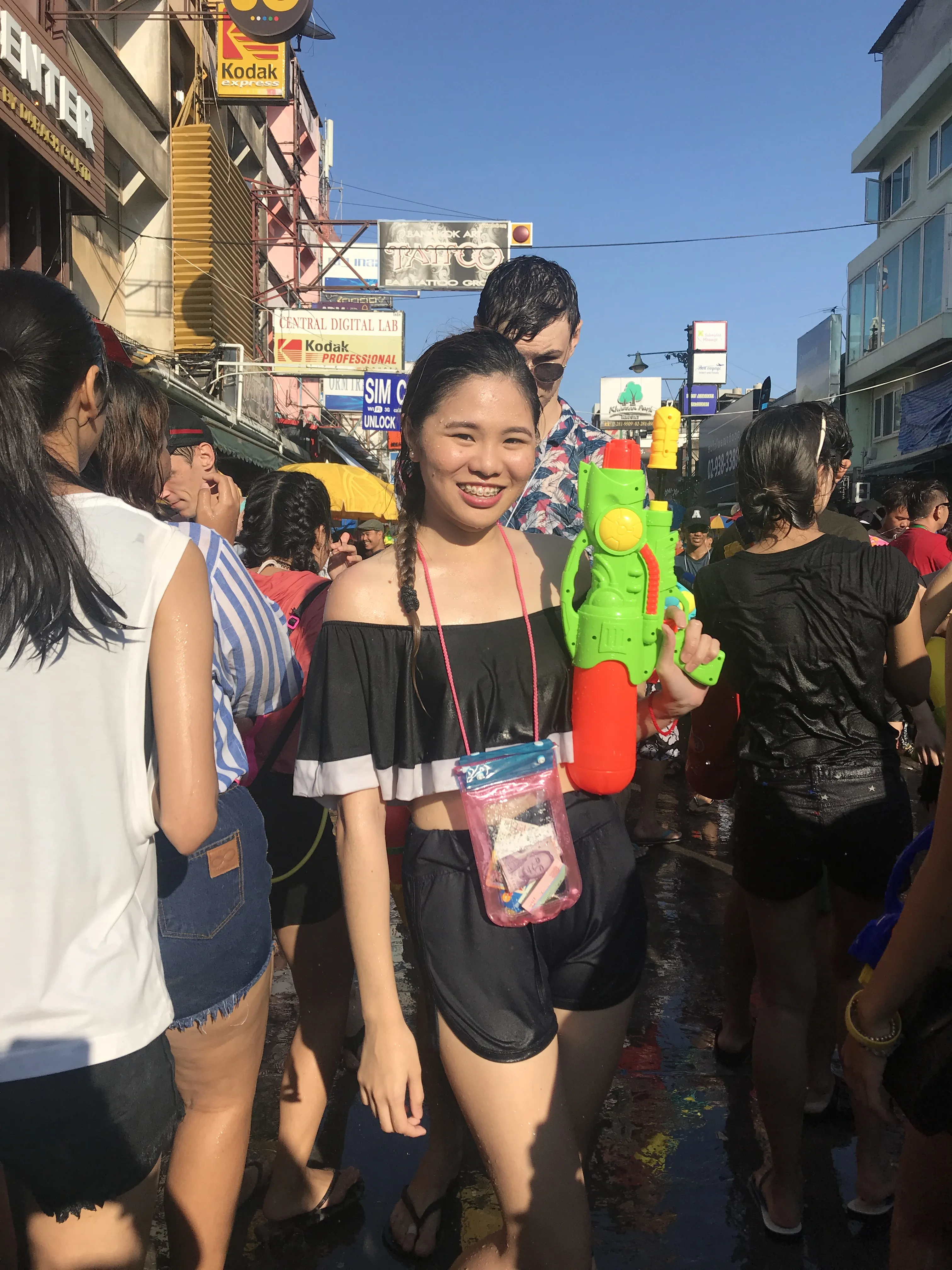 Ready for the Songkran Water Festival in Bangkok, Thailand
Ready for the Songkran Water Festival in Bangkok, Thailand
Even outside of Songkran, Bangkok offers endless attractions. Explore the magnificent Grand Palace and the adjacent Wat Phra Kaew (Temple of the Emerald Buddha). Visit Wat Pho (Temple of the Reclining Buddha) and Wat Arun (Temple of Dawn) across the Chao Phraya River. Navigate the city using the efficient BTS Skytrain and MRT subway systems, or take a scenic boat ride on the river.
Bangkok is a paradise for food lovers. Spend the evening exploring the countless street food stalls, particularly in areas like Chinatown or near Khao San Road. Try classic Thai dishes like Pad Thai, Green Curry, Mango Sticky Rice, and Satay. The energy of Bangkok’s street food scene is infectious and offers an authentic taste of Thai life.
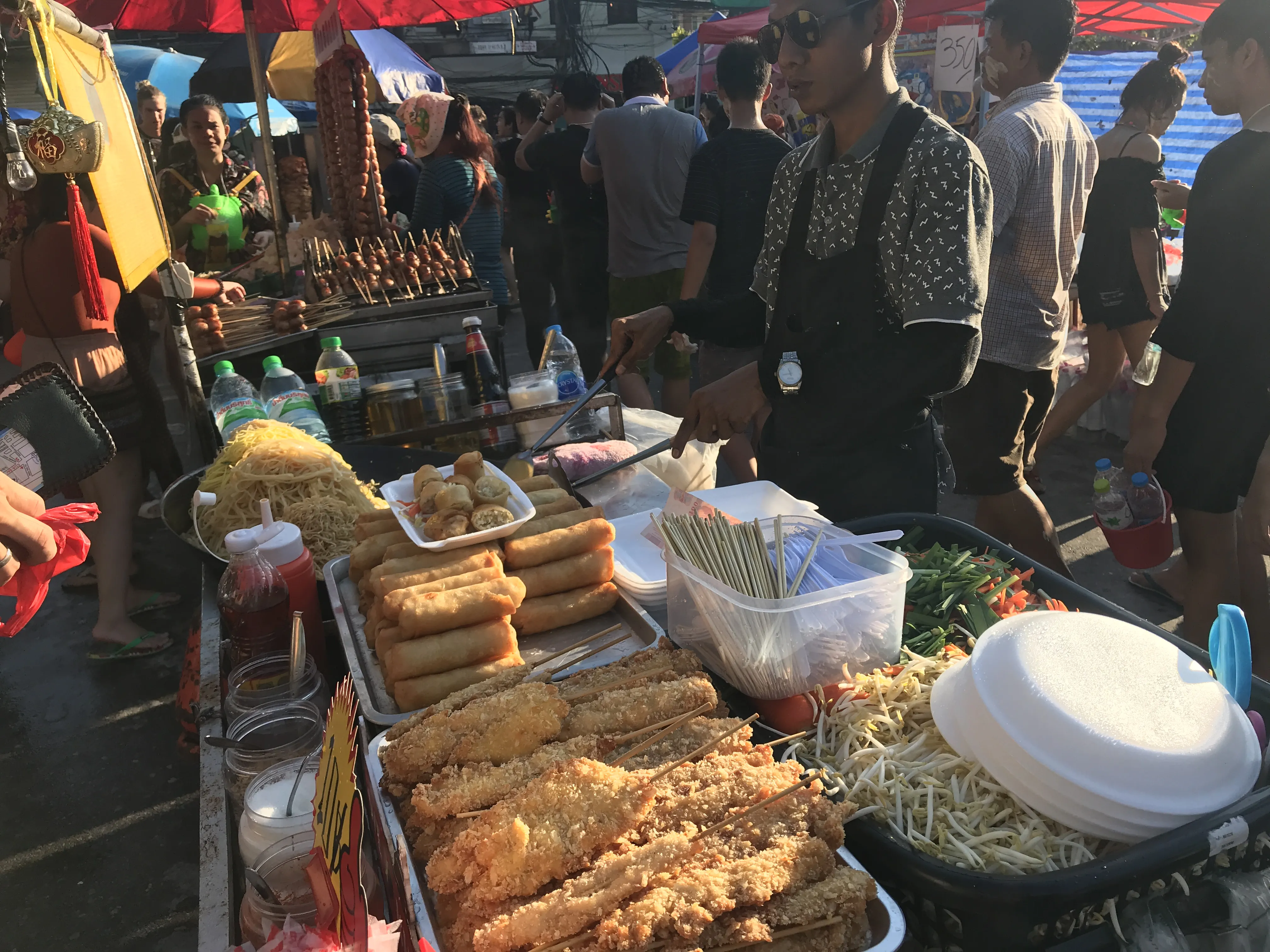 Exploring delicious street foods in Bangkok
Exploring delicious street foods in Bangkok
Experiencing Bangkok’s blend of ancient temples, modern shopping malls, and bustling streets is a fitting culmination for your Backpacking Thailand Vietnam Cambodia route. The city provides a fascinating contrast to the historical sites of Cambodia and the rural landscapes of Vietnam and Northern Thailand.
If you happen to visit during Songkran, be sure to read up on personal experiences like “Thailand : My first Songkran Experience in Bangkok” to get a sense of what to expect during this unique festival.
Day 11: Departure from Bangkok
On your final day, it’s time to say goodbye to Southeast Asia. Depending on your flight schedule, you might have time for some last-minute souvenir shopping or grabbing a final delicious Thai meal. Getting to the airport from Bangkok city center is straightforward using the Airport Rail Link, taxis, or ride-hailing services.
If your departure day happens to fall during the peak of Songkran, be mindful that transportation might be affected by the water festivities. Booking a ride directly from your accommodation is a sensible option to avoid getting soaked on your way to the airport!
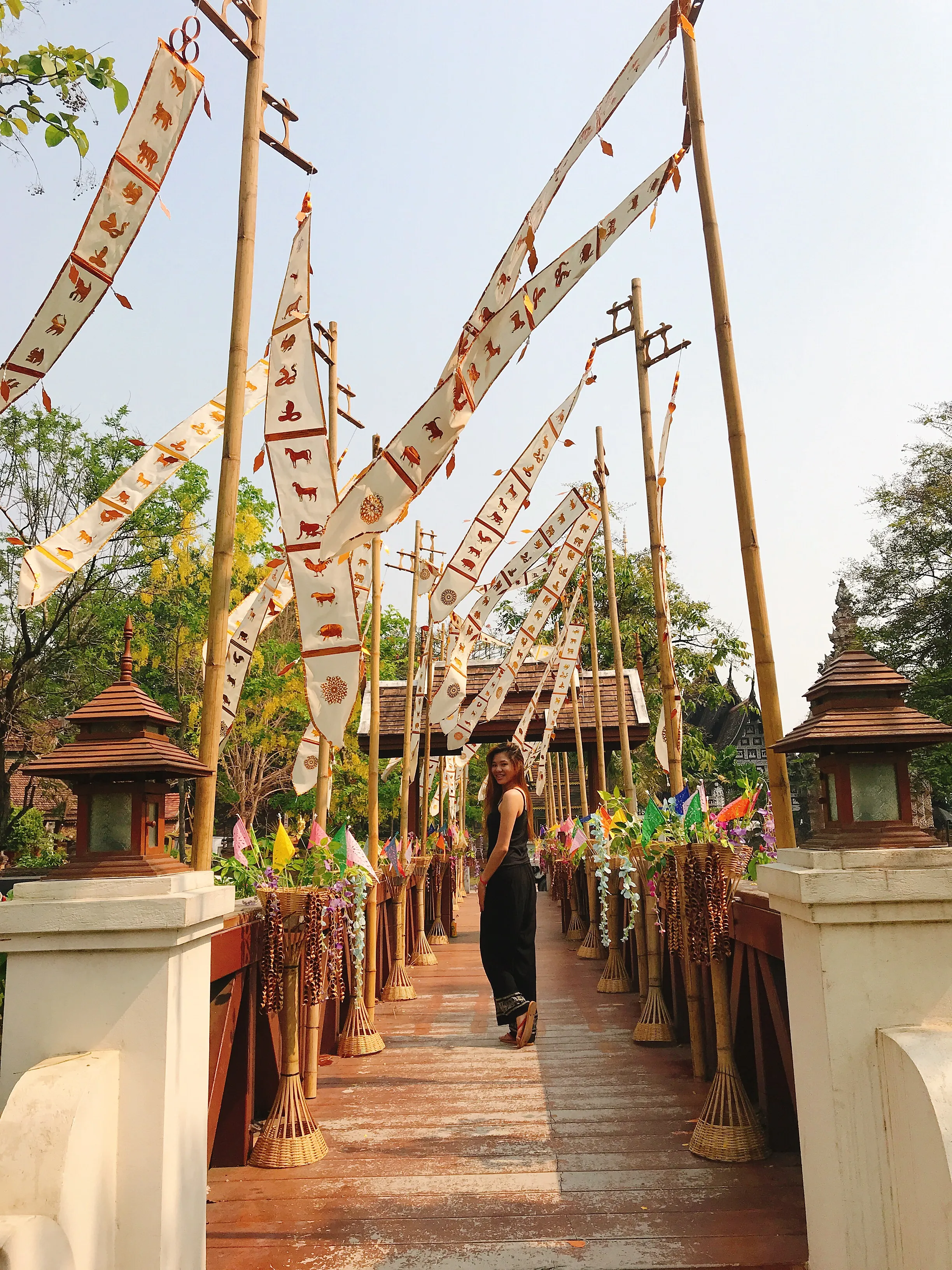 Travel blogger exploring Southeast Asia
Travel blogger exploring Southeast Asia
This marks the end of an incredible Backpacking Thailand Vietnam Cambodia adventure. You’ve experienced the diverse cultures, savored the distinct flavors, witnessed historical wonders, and navigated the logistical challenges that make backpacking such a rewarding way to travel. The memories and experiences gained on this trip will undoubtedly last a lifetime.
Beyond the Itinerary: Deepening Your Experience
Backpacking Thailand Vietnam Cambodia is about more than just ticking off landmarks. It’s an opportunity for deep cultural immersion. Engage with locals, try your hand at learning a few basic phrases, and be open to spontaneous experiences. The warmth and hospitality of the people in all three countries are incredibly welcoming.
Culinary Adventures
Food is a massive part of the experience when Backpacking Thailand Vietnam Cambodia. Vietnamese cuisine is known for its fresh ingredients and balanced flavors, from street-side Pho and Banh Mi to intricate dishes. Cambodian food, while perhaps less globally famous, offers delicious curries (like Fish Amok) and unique flavors influenced by neighboring countries. Thai cuisine is vibrant and diverse, ranging from spicy curries and flavorful stir-fries to delightful desserts and regional specialties like Chiang Mai’s Khao Soi.
Don’t be afraid to try street food – it’s often where you’ll find the most authentic and delicious dishes at incredibly affordable prices. Each meal tells a story about local ingredients, cooking methods, and cultural traditions.
Historical and Cultural Insights
Exploring the historical sites, from Vietnam’s wartime history and colonial architecture to Cambodia’s ancient Khmer empire and Thailand’s magnificent temples, provides a profound understanding of the region’s past. These sites are not just ruins or buildings; they are testaments to resilience, faith, and artistic achievement.
Engaging with the local culture means observing customs, understanding religious practices (like visiting temples respectfully), and perhaps even participating in a local festival if your timing is right (like Songkran). These interactions add layers of meaning to your journey.
Practical Tips for Backpacking
- Visas: Check visa requirements for your nationality for Vietnam, Cambodia, and Thailand well in advance. E-visas are often available for certain nationalities.
- Transportation: Buses are the primary mode of transport between countries for backpackers. Within cities, use local buses, taxis, ride-hailing apps (Grab is popular), or tuk-tuks. Overnight buses or trains are efficient for long distances within countries.
- Accommodation: A wide range of hostels, guesthouses, and budget hotels cater to backpackers, offering social environments and essential amenities.
- Budget: Southeast Asia is relatively affordable for backpacking. Your major costs will be transportation, accommodation, and entry fees. Food is generally very inexpensive, especially street food. Plan for approximately $30-$50 per day, depending on your style.
- Packing: Pack light! Essentials include breathable clothing, comfortable walking shoes, swimwear, a universal adapter, basic toiletries, a first-aid kit, and insect repellent. A backpack is easier than a suitcase.
- Connectivity: SIM cards are readily available and affordable in each country, providing easy access to data for maps, communication, and booking.
- Health: Consult your doctor about necessary vaccinations. Be mindful of food and water safety, especially with street food (look for vendors with high turnover).
- Safety: Southeast Asia is generally safe for travelers, but be aware of common tourist scams. Keep valuables secure and be cautious when walking alone at night.
Frequently Asked Questions (FAQ)
Q: How long do I need for Backpacking Thailand Vietnam Cambodia?
A: While you can hit highlights in 7-10 days, ideally, allow at least 2-3 weeks to comfortably explore key areas in all three countries without feeling rushed. The 11-day itinerary above is quite fast-paced but covers major attractions.
Q: What’s the best route for Backpacking Thailand Vietnam Cambodia?
A: The common routes are north-to-south (e.g., Bangkok -> Cambodia -> Vietnam) or south-to-north (e.g., Ho Chi Minh City -> Cambodia -> Thailand). The direction often depends on flight deals and personal preference. Starting in Vietnam allows for travel upwards towards Thailand.
Q: How do I travel between countries?
A: The most popular method for backpackers is overland travel by bus. Buses connect major cities and border crossings. Flights are also an option if you have less time or prefer not to spend hours on a bus, but they are more expensive.
Q: What about visas for Backpacking Thailand Vietnam Cambodia?
A: Visa requirements vary greatly depending on your nationality. Many nationalities can enter Thailand visa-free for a certain period. Vietnam and Cambodia often require visas, which can sometimes be obtained on arrival at land borders or airports, or applied for online (e-visa) or in advance at embassies. Always check the latest requirements specific to your passport before you travel.
Q: Is it safe to backpack solo in these countries?
A: Generally, yes. Southeast Asia is a popular region for solo travelers, and millions explore it safely each year. Use common sense safety precautions: be aware of your surroundings, don’t flaunt valuables, use reputable transport, and inform someone of your itinerary. Hostels are great places to meet fellow travelers.
Conclusion
Embarking on a journey Backpacking Thailand Vietnam Cambodia is an adventure that promises incredible diversity and unforgettable experiences. From the historical intensity of Vietnam and the ancient spirituality of Cambodia to the vibrant energy and natural beauty of Thailand, this route offers a comprehensive taste of Southeast Asia. By combining cultural immersion, culinary exploration, historical discovery, and practical backpacking strategies, you can create a journey that is both enriching and exhilarating. Pack your bags, stay open to the unexpected, and get ready to explore this captivating trio!
